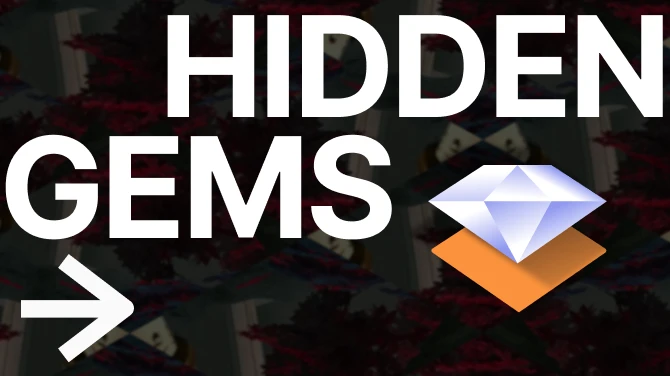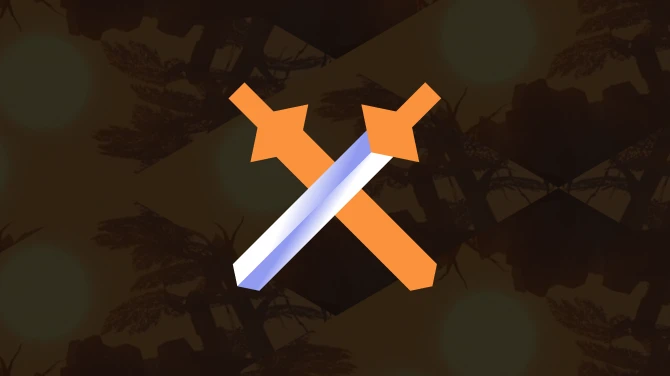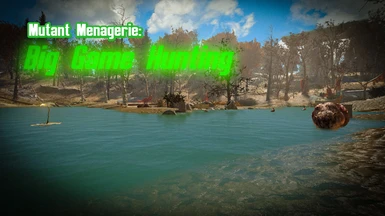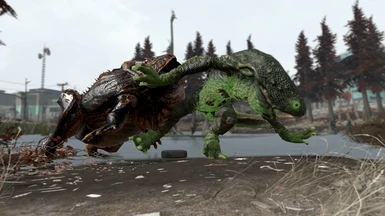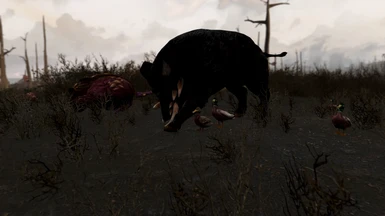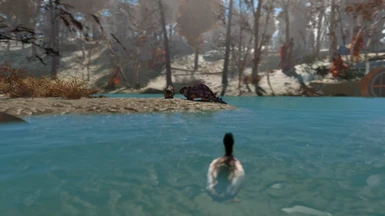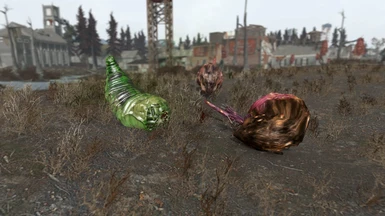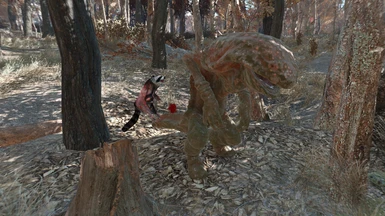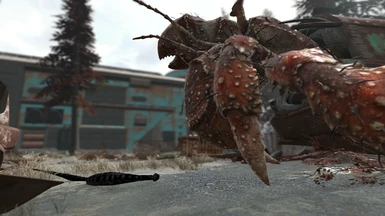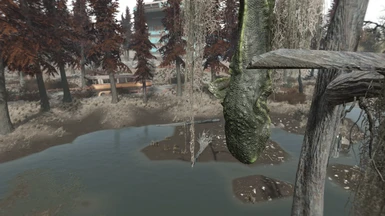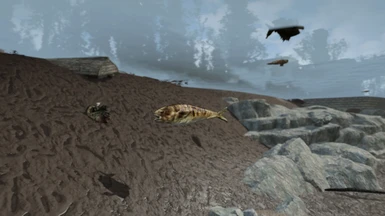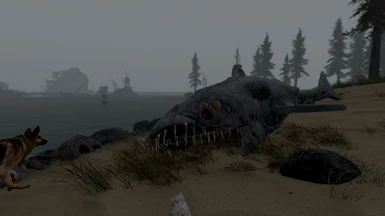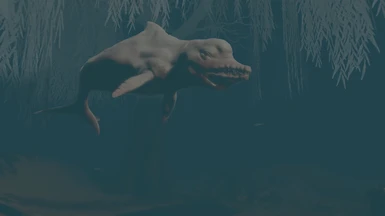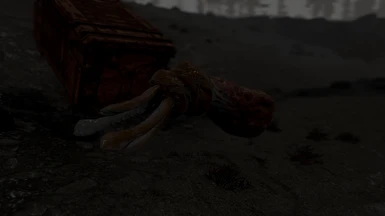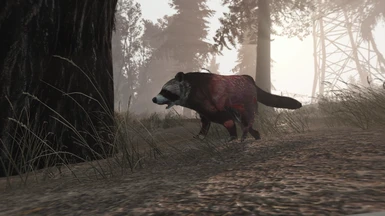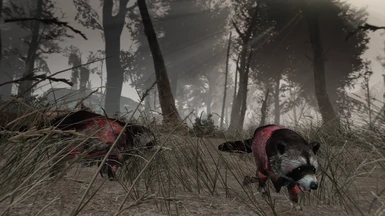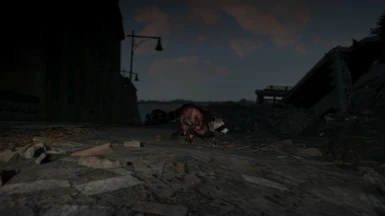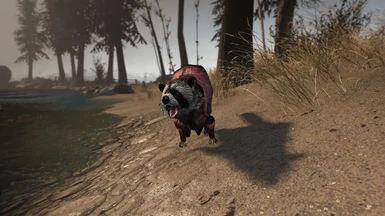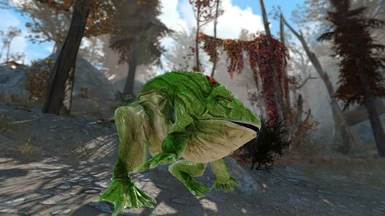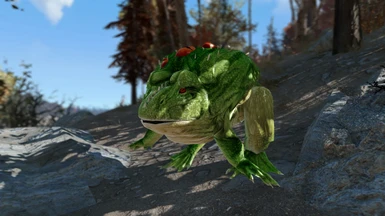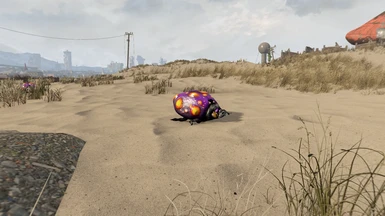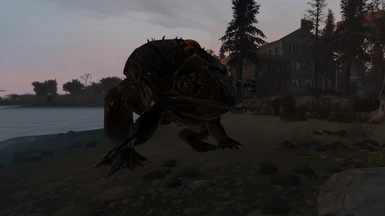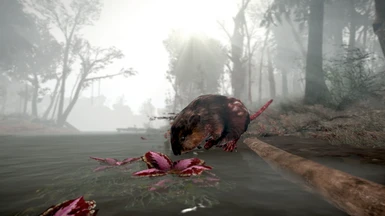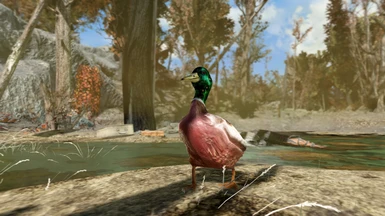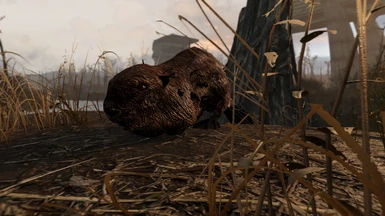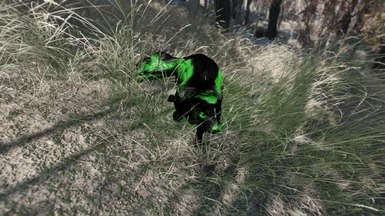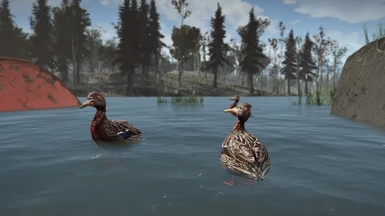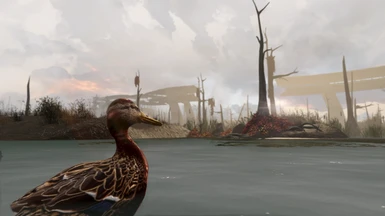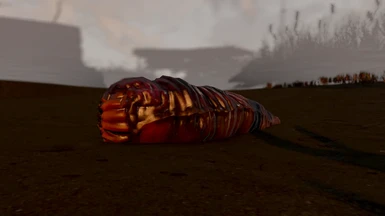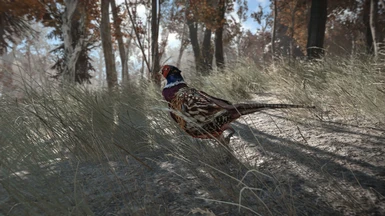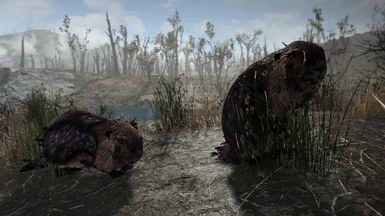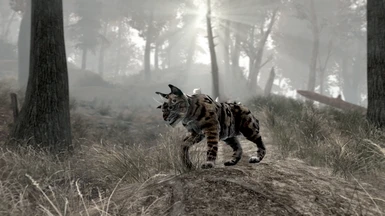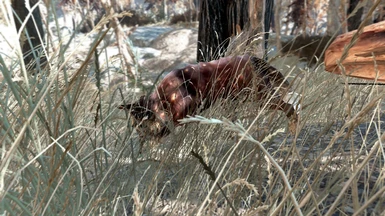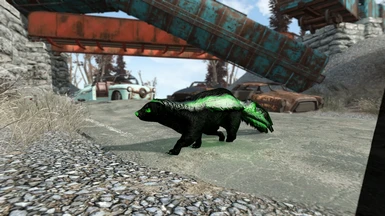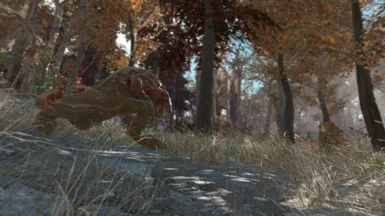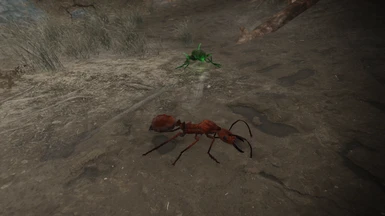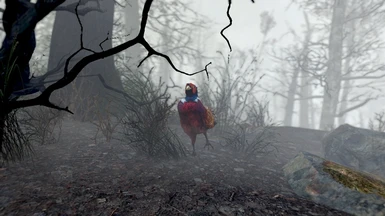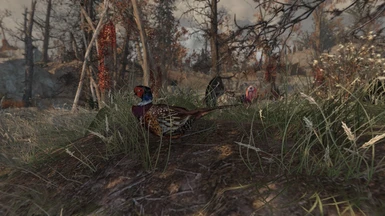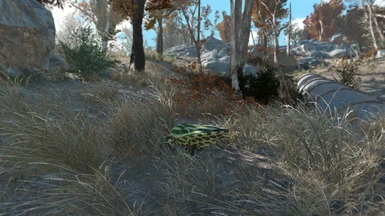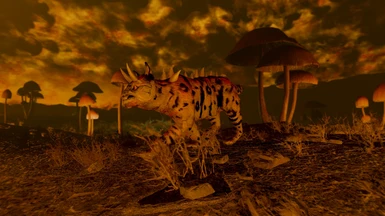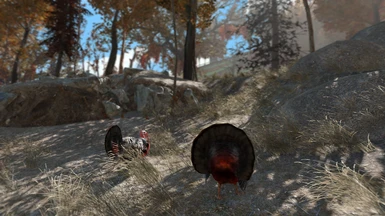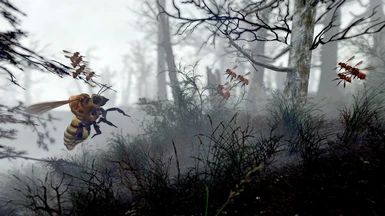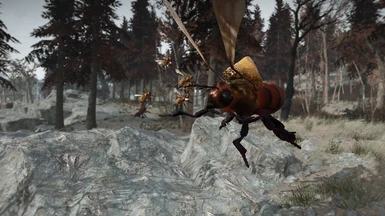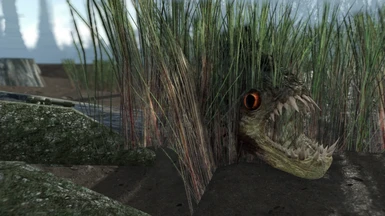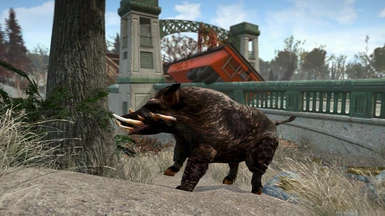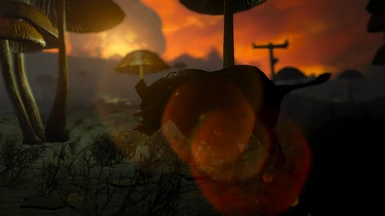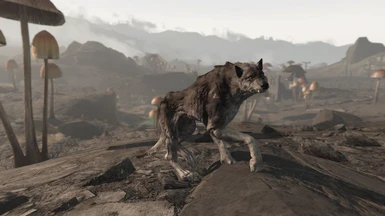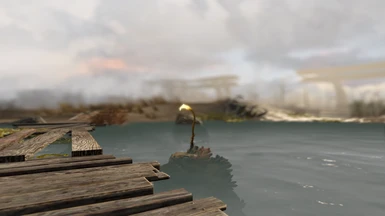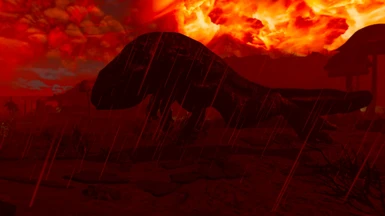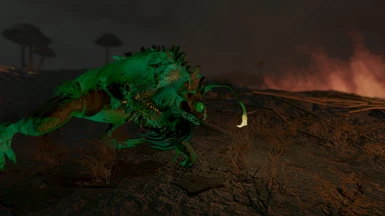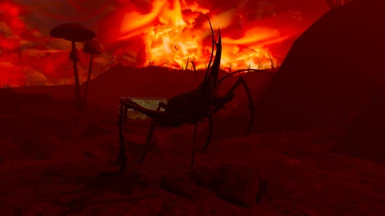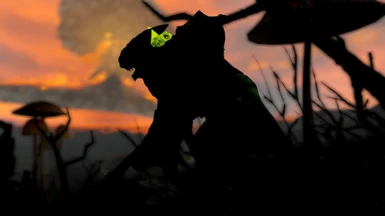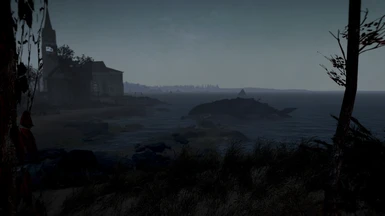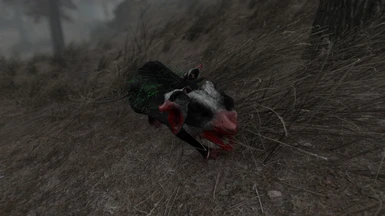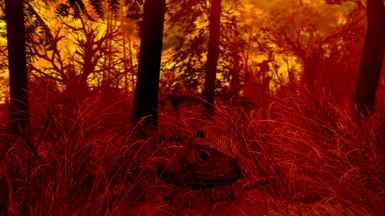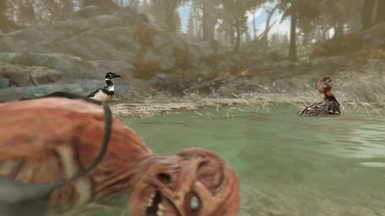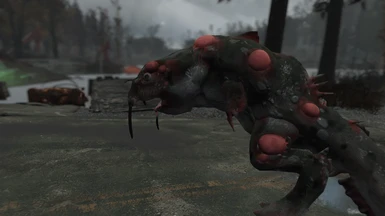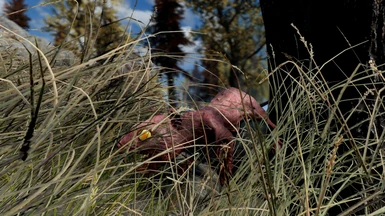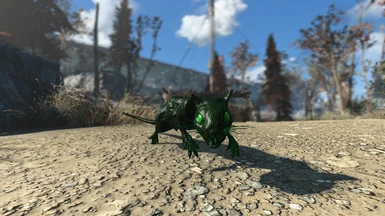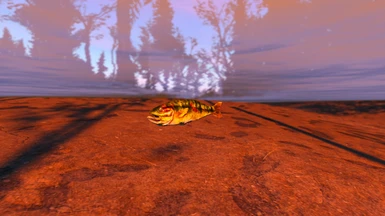File information
Created by
StamperDoesModsUploaded by
StamperDoesModsVirus scan
About this mod
Mutant Menagerie fills the Commonwealth to the brim with all new creatures gathered from a wealth of public access sources. These new, lore-friendly creatures come with unique drops and hand-placed spawns. This mod also adds in dozens of dynamic spawns for new, vanilla, and DLC creatures alike!
- Requirements
- Permissions and credits
-
Translations
- Ukrainian
- Spanish
- Russian
- Mandarin
- Korean
- German
- French
- Mirrors
- Changelogs
- Donations

This mod has been retired!
All previous iterations of Mutant Menagerie will remain available, but they have been laid to rest by me - the author.
Mutant Menagerie: Life Finds a Way is considered the final version of Mutant Menagerie - replacing all previous versions.
The Sole Survivor stood exhausted at the shores of a murky, discolored lake. In their mind, rapidly playing on a loop, the events of the last eight hours laid themselves bare. Staring southward across this dammed up old reservoir - the Survivor truly began to understand. Their life, one which they had known so well just this morning, would never be the same. The Survivor took in their surroundings - wondering if it could have really been two centuries since he had visited the surface. In the wake of the bombs, the perceived end of humanity, stood a new and wholly alien world. From the ashes old ruins sprouted a wasteland of perpetual, nuclear autumn. The rusty horizon was teeming with life as strange as it was familiar. Ducks chirped and quacked just feet away – lacking most of their feathers and, the Survivor presumed, their flight. On a muddy dune to the southwest, a beaver covered in jutting spikes and jagged bone spurs crawled out of the water – to the shock and dismay of a startled, two-headed buck. And on the shoreline opposite the Sole Survivor, meeting their wandering gaze, a bulbous, bloated muskrat clothed in matted fur and yellow boils – Standing nearly at the height of a grown man.
Here on the shores of this forgotten lake, The Sole Survivor recognized that the world had never truly ended. Life changed, adapted, and evolved – adopting the ruined husk of the old world as its new ecosystem. As a deep, lurching croak echoed out from an unknown source somewhere off past western tree line, the Sole Survivor was met with one final truth. Any humans left alive in this brave new world no longer stood at the top of the food chain. Finally collecting their thoughts, the now-focused Survivor brushed off their worn jumpsuit, unholstered their trusty pistol, and began making their way onward. They would conquer the beasts of this new Commonwealth. They would find their son. There wasn’t a mutant in all of Massachusetts big or vicious enough to stand in their way – or so they thought.
Welcome home.
Part 1: Overview
As of update 1.3, this mod adds 32 NEW and LORE-FRIENDLY creatures, of all shapes and sizes, to Fallout 4’s Commonwealth! It also introduces lore-friendly creatures from Fallout 4’s DLCs to the Commonwealth through the use of dynamic spawns. All spawns have been placed into the open world by hand to mitigate overcrowding the Commonwealth - and to give the Commonwealth's ecosystems a bit of an artist's touch. With Mutant Menagerie, the Commonwealth is about to become a much livelier place!
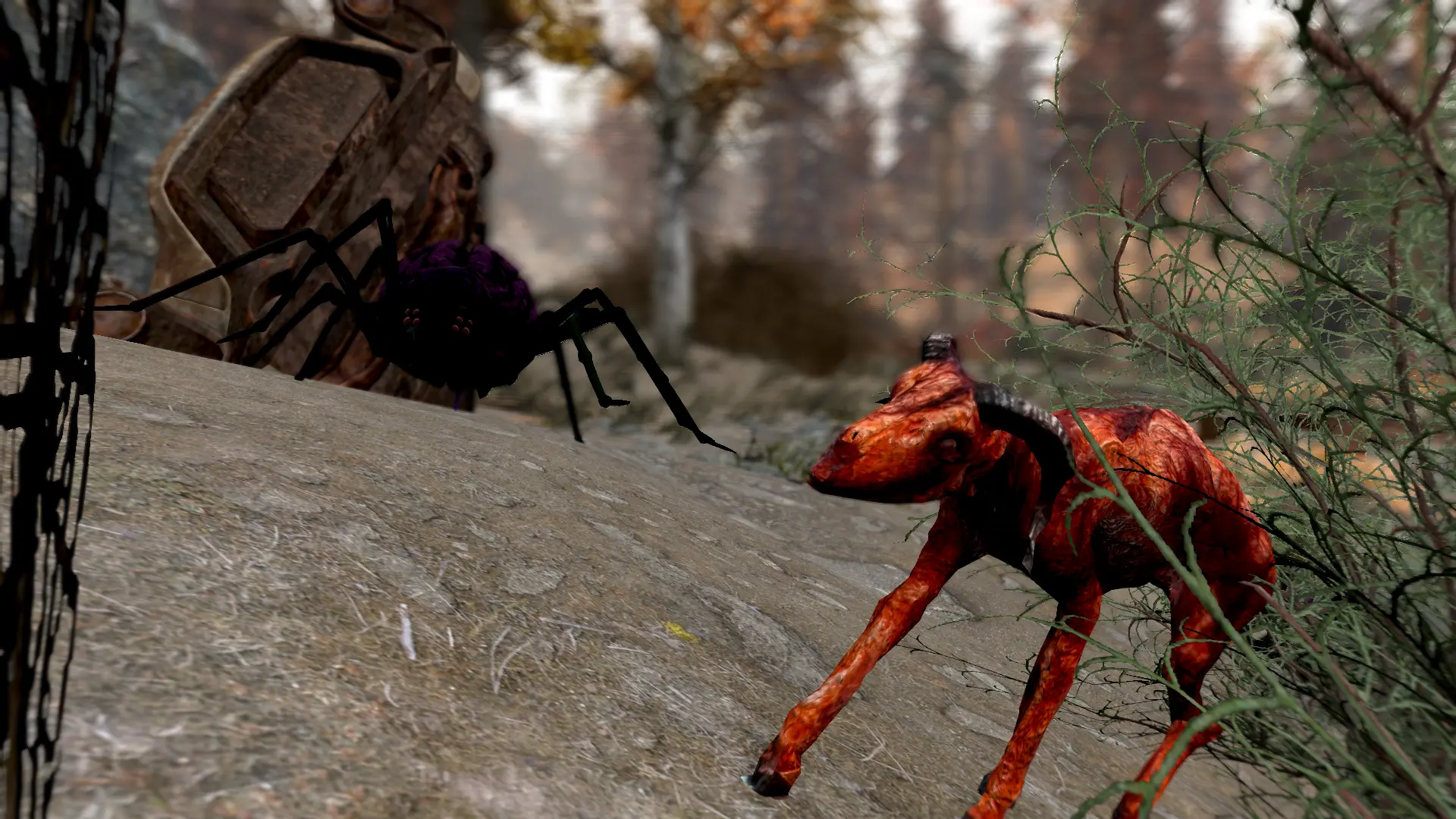
1) Dynamic Spawns
Many of the spawns added in this mod utilize custom leveled actors designed to introduce random, level-appropriate creatures each time the actor respawns. These dynamic levelled spawns are split into predators and prey – with the intent to create fully-fledged and randomized ecosystems throughout the different biomes of the Commonwealth. These spawns do not utilize creatures that are already too common in the Commonwealth (IE mirelurks), electing instead to prioritize new creatures and creatures from the DLCs. Most creature spawns are found in the wilderness areas of the Commonwealth rather than urban areas. For performance reasons, there are no creature spawns in the ruins of Downtown Boston.
2) DLC Creature Integration
DLC creatures have been added to the Commonwealth through dynamic and levelled spawns. Ambush encounters have been hidden throughout the
map for some creatures, ensuring that your next adventure into the Commonwealth’s wilderness will have a few surprises. Lower level, reduced-stat variants of high level creatures were also created, ensuring that endgame beasties like gulpers, anglers, and cave crickets can appear occasionally in the early game to spice up combat without entirely steamrolling the protagonist. Great care was taken with these spawns, as with all others, to ensure that they fit into the world without feeling crammed in or overwhelming in any way. They are meant to spice up your experience, not entirely redefine it.
3) New Creatures
This mod adds a wide roster of 32 new mutants to the Commonwealth – all of which are nonhumanoid and as lore-friendly as possible. There are hand-placed spawns for all creatures in addition to their integration into my dynamic spawns. The new creatures are split into three categories – Heavy Hitters, Hybrids, and Game creatures. Ambient “Game” creatures roam the Commonwealth avoiding hungry mutants and trigger-happy hunters. Heavy-Hitters seek to rough you up and ruin your day. Most fulfill special roles in the combat sandbox to challenge the player - making the game much harder. Hybrids generally land somewhere between the two categories - playing a more neutral role in the ecosystem. They all have levelled variants, legendary variants, and drop loot of increasing quality to match.
4) Cooking and Crafting
Players can cook new recipes, scrap or sell critter parts, and roleplay the wasteland hunter of their dreams. Exploring the Commonwealth’s wilderness and hunting with Mutant Menagerie is meant to provide a viable alternative to the dungeon crawling loop that Fallout 4 is known for. One of my goals with this mod was to add a Red Dead Redemption 2–inspired hunting loop to the game. Pelts vary in quality from poor, to good, to perfect. Meat, on the other hand, comes in two categories – regular meat and prime, plump, or succulent meat (creature type dependent). A critter’s size is indicative of its quality, so keep an eye out for the bigger animals! Heavy Hitters also provide similarly-lucrative loot items, but they won’t give them up easy. Mutant Menagerie dares you to explore the wild, gather ingredients of all kinds, and embrace your inner hunter-gatherer extraordinaire! There are even new recipes that prioritize common vanilla fallout 4 ingredients, allowing you to use previously boring items from the vanilla game in new ways. New items sell for more than their vanilla equivalents, new recipes will require more time and effort to craft, and the benefits for your creations will be top-tier – forcing you to decide whether you want to sell that roasted critter or use it during your time of need.
5) Scripted Integration (BETA)
Creatures are now broken up into proper factions or families. New Mutant Menagerie creatures and some DLC creatures are integrated into the leveled lists of other creatures - increasing the variety in creatures you will encounter. Now, instead of a pack of simple radroaches, you will encounter roaches, ants, boombugs, and other small insects! Instead of a pack of molerats, you'll encounter rad-shrews, rad-rats, pig rats, and even the dread cave rats! Additionally, vanilla creatures have a chance to drop Mutant Menagerie loot items.
IMPORTANT: Keep in mind, some vanilla files had to be edited to properly integrate new creatures. Examples of this include checking the "calculate for each item in the count" box for the vicious dog LCHAR, or fixing the rad-rat leveled actor to reference the basic traits of its LCHAR (which actually seems to be an oversight by Bethesda). If you are uncomfortable with these changes, don't use the Beta plugin!

Regarding "Lore Friendliness"
Lore - "A body of traditions and knowledge on a subject or held by a particular group, typically passed from person to person by word of mouth." - OxfordLanguages Dictionary
"a particular body of knowledge or tradition" - Merriam Webster
Popular synonyms/similar words include: Mythology, Folklore, Backstory, History, Legends
What constitutes Lore-Friendly is something a lot of people like to argue about, and are very, very opinionated about - often pointlessly so. I say pointlessly because Lore-Friendly isn't really a matter of opinion. Lore is backstory, legend, and history. Things are factually Lore-Friendly, and adhere to mythology and backstory, while other things are not, and contradict mythology and backstory. There is a line where conjecture and open-interpretation must be considered and a judgement call must be made, but that is very rare. The fact of the matter is, whether you like it or not, lore-friendliness is not up to the individual. The following criteria below are my rules on canon, and the criteria that I use to determine whether a creature is, in fact, lore-friendly:
1) The franchise owner/current-producer is the arbiter of canon.
If you own the rights to something, you have the sole right to define (or redefine) its canon and lore. This first rule is important for a lot of you classic Fallout lovers. For my mod, canon is defined by the one holding the keys to the kingdom. That means Bethesda is in charge - like it or not. If they say something is de-canonized, it is. If they make a retcon, that retcon is the new canon. If they add new information to the world, it must be considered and accepted - even the information that post-dates Fallout 4 (IE: Fallout 76). The minute you start picking and choosing what's canon based on which franchise interpretation's take you liked better, that's the minute you lose any objective thought process for determining what constitutes lore-friendly. One popular point of contention here is the Fallout Bible. It has been largely de-canonized by the current arbiters of Fallout's destiny - so it's de-canonized here, too.
2) Something is either lore-friendly or it isn't. There is almost never an in-between.
Lore-Friendly simply means that something doesn't contradict lore or break pre-existing canon. Period. It DOES NOT mean whether or not something is tonally or thematically consistent with universe, or whether it breaks with the established conventions of the franchise. That is another issue entirely - and one that allows for the interjection of opinion and artistic interpretation. Whether or not something "works" in a fictional universe, from a worldbuilding standpoint or otherwise, is a very personal discussion that varies greatly based on who's discussing it. But none of those feelings or personal beliefs apply to the discussion of lore-friendliness. The most frequent examples of this debate, being disguised as lore debates, are when people argue that artistic changes from game-to-game are not lore-friendly. In the world of fictional universes, artistic interpretation and lore-friendliness are two separate discussions. You may not like the new power armor design or gameplay changes associated with it, but that argument does not belong in the lore-friendliness debate. Artistic interpretation is an accepted feature of the video game and wider entertainment industry - and especially so at Bethesda. It is important to respect that, rather than be distracted by it.
3) Pre-existing, canonized lore matters, but must be properly interpreted.
Going off of the first point, existing lore is the bulk of how we determine lore-friendliness. In a situation where canon information on a topic exists, you must use critical thinking to analyze the extent of a statement. For example, In Fallout: New Vegas, Robert House states cats are extinct as part of a snide joke about skinning cats. If we didn't know what we knew post-Fallout 4, how would we analyze House's statement from a lore implication perspective? Would we say that all cats in the franchise are extinct? Of course not, because how could Robert House possibly know that? Without evidence or affirmatory statements from others, the most that we could conclude is that cats are either extinct worldwide, extinct in the American Southwest, or exist in such sparse numbers in the American Southwest that one of the smartest men in the world, with an incredibly advanced and well-established surveillance state, could be tricked into thinking they had died out. Since there is no definitive evidence or corroborating statements in-game to verify or dispute House's claim, we cannot call the existence of cats in, say, the Commonwealth, a lore-break from a logical standpoint. It is objectively lore-friendly given the context. We could, however, say that a sudden, healthy population of housecats in the Mojave Wasteland would be lore-breaking - given that it is within House's domain of influence. When in doubt, use the Socratic method.
4) Game lore supersedes out-of-game lore.
As stated in the first rule, Bethesda defines what constitutes lore - not the old Black Isle devs, not Obsidian, and not Chris Avellone's twitter account. And Bethesda devs have stated numerous times that lore in the game matters more than lore that is not in the games. So when one comes across lore that contradicts itself between game and expanded universe content, the game wins. If you respect their right to interpret the universe how they want, then you must adhere to their methodology as-well. We don't pick and choose here, as that would once again be introducing an inherent bias.
5) If there is no information, it is a blank slate.
This may seem obvious to some, but it must be stated anyway. If no information exists on a subject, then it is an open book. If something is neither stated to exist or not-exist, or simply not mentioned at all, than any interpretation is objectively lore-friendly. If your fan project involves raccoons being extinct, and raccoons have never been mentioned in the history of Fallout franchise canon, then your project is lore-friendly. If your fan project features a mutant species of raccoon as one of its frontrunners, then again, your project is lore-friendly. No information doesn't mean you decide whether something's lore-friendly based on your feelings. It means any interpretation of the untapped subject is lore-friendly, and you are free to interpret something how you wish. To take this a step farther, let's look at the radtoads from my mod. Radtoads are an established creature in Fallout 76, but their fate after the first 20-something years of the apocalypse is unknown in the lore. So, using the logic we just laid out, determining that radtoads may have mutated further into giant walking tanks 200 years later is a valid, lore-friendly take on the species. Deciding they remain unchanged, have gone extinct, or are exclusive to Appalachia is ALSO a valid, lore-friendly interpretation. Do not argue about what isn't there. You'll live longer.
6) Cut or de-canonized content that hasn't been retconned or replaced is not law, but is still a valid interpretation.
This one is a little tricky, because it requires an understanding of the rules we laid out beforehand. Basically, if something, especially game content, has been declared non-canon, but has not been overwritten, it falls into the category of "valid interpretation". Elements of both Van Buren and Fallout Tactics, for example, have been canonized sparingly in later iterations of the franchise - despite both being separated from the lore by Bethesda. What this means is that while the content of something like, say, the Fallout Bible cannot be used to declare something non-canon, much of it (the bits that have not been overwritten or retconned) still represent valid, lore-friendly interpretations of certain subject matter. Even Bethesda still pulls from the Fallout Bible and other de-canonized material occasionally. What this means is, while it may no longer be canon that wanamingos went extinct after Fallout 2 - as stated in the Fallout Bible - and that information can no longer be evidenced to disprove their existence in future/fan material, if your fan project involves wanamingos going extinct as a major plot point, that is a valid, lore-friendly interpretation of the Fallout universe.
7) Real-world logic matters when it does, and doesn't when it doesn't.
Fallout is one of those franchises where it takes logic and real-world inspiration incredibly seriously in some places, but is essentially a cartoon in others. For the sake of determining lore-friendliness, it's important to take into account when-and-where the franchise gets serious with logic, and where it gets goofy. Energy weapons, for example, are treated very cartoonishly and purposefully disobey the laws of physics and reality. Lasers can kick like a shotgun when fired because the universe isn't concerned with the realism of many of its more-pseudoscientific elements. Human issues, on the other hand, are usually treated realistically, with questions about politics, ethics, and the human condition being at the core of the Fallout franchise's writing and quest themes - and largely inspired by real events. This all borders very closely on the realm of "artistic interpretation" that we outlined in Rule 2, but uniquely has lore implications when it comes to certain elements.
Creatures, specifically, tend to be taken quite seriously in Fallout. Outlandish designs aside, each creature tends to be consistent with a known real-world counterpart that fits ecologically within an environment. They usually have deep backgrounds, clear real-world and/or pop culture inspirations, and play crucial roles in their ecosystems outside of killing/fleeing from the player. Knowing that the franchise takes the topic of its creatures seriously, we could determine that lore-friendliness is strengthened when adhering to the ecology of real-world animals and creatures. Various exceptions do exist, however. This is primarily because pet stores, zoos, and wildlife sanctuaries exist - allowing for conjecture. In summation, this is a rule that is best used for strengthening lore-friendliness and adherence to tone when creating, rather than declaring something to not be lore-friendly. If your entire argument for declaring something lore-breaking boils down to "Its pre-war counterpart isn't native to this environment and climate," you are going to be disappointed when, as a counterargument, your adversary submits a twenty-page backstory detailing a 200 year-long Galápagos tortoise migration - the ending of which outlines the settling of the species in Washington DC and their sudden turn to cannibalism. Is it ridiculous? Yes. Can you disprove it? No. Because tonally-inconsistent interpretations of the world are still, objectively, lore-friendly interpretations of the world - so long as they adhere to, and exist within the confines of, existing lore. The correct description of this type of content is setting-inappropriate or tonally-inconsistent - not lore-breaking. Breaking a setting or its established tone is different from breaking its lore - IE mythos, history, and/or backstory.
Why Did I Make This Mod?
Incompatibilies and Bugs
Mutant Menagerie was built to be dropped into a load order as a permanent mainstay with very little digital footprint on your game. I’ve regularly error-checked the mod in FO4 Edit, Bash, and Merge Plugins to make sure that the mod is clean and runs smoothly. With that said, the following list below outlines the documented issues and incompatibilities you may encounter when running Mutant Menagerie, and suggestions on how to resolve them based on the information available to me. If you have knowledge regarding one of these issues that may help others, please feel free to leave a comment.
KNOWN ISSUES, INCOMPATIBILITIES, AND FIXES:
- SCRIPTED KILL MODS. According to SoundOfSnow and the Buffout Dev - who were kind enough to reach out - Replace Any Actor with Any Actor by SKK, and any similar mods that use scripts to kill actors, may crash the game when used with Mutant Menagerie. Due to the "torso" Bodypart file in the Bodypart Data of certain creatures lacking an Actor Value, a mod that attempts to kill an actor using that Bodypart Data via script can crash the game. I will fix what I can and amend any offending files on my end for the next release. Until then, consider any such mod incompatible with Mutant Menagerie.
- VANISHING CREATURES/ ODD PHYSICS. Certain creatures seem to fade temporarily when affected by status effects that add a visual mask - like acid, poison, or legendary mutations. This issue is being looked into. Additionally, wacky or insane ragdolling with the models may occur upon death. Creatures may continue moving for a few seconds, launch into the air, or stutter and seize. These types of interactions are unavoidable and unfixable, and occur in most custom creature or creature-scaling mods to some extent. If it's too immersion breaking, don't use the mod.
- WORLDSPACE EDITS. Mods that edit and/or add to the vanilla worldspace of Fallout 4, such as custom settlements, Boston FPS Fix, or South of the Sea, may experience issues. Load Mutant Menagerie above such mods to ensure their changes take priority.
- HEADLESS SYNTHS (BLANK ACTORS). There have been reports of blank actors (headless synths) appearing on some load orders - especially heavy load orders. As far as I am aware, this issue is caused by either circular levelled lists or LChar (leveled actor) files being forced to produce an actor where none exists. Possible solutions to resolving this include sorting masters in your load order via FO4Edit, removing other creature or spawning mods (including mods that use scripted injection), or lightening your mod list to minimize the chance for any odd incompatibilities. The headless synth issue has also been partially attributed to running Mutant Menagerie alongside the mod "Unique NPCs" - although I cannot personally confirm this.
-INVISIBLE CREATURES. This has proven on at-least one occasion to be symptomatic of using outdated unofficial patches. It may occur as a result of a mod conflict or by mashing various versions of my mods together that don't match.
-FLOATING CREATURES. There are rare occasions where creatures may not react to collision - as if TCL were toggled via console. I have only encountered this issue while testing different versions of the mod on the same save - especially if bodypart data or rigging is altered significantly between builds. Possible solutions include rebooting the game, a clean reinstallation of the mod, or starting a fresh save game. If problems persist, make sure you do not have any mods that alter vanilla bodypart data, skeletons, etc. of creatures featured in the mod.
- PERK OVERHAULS. Mutant Menagerie uses perks as requirements for certain crafting recipes. Mods that remove or disable vanilla perks will conflict with my mod. If perks are outright deleted, the game will freeze-crash or CTD in the crafting menu. Old versions of Creative Perks Plus are known to cause crashes, but as of the latest build of that mod, all issues have been resolved. Update Creative Perks Plus to its latest build first if you are experiencing issues. If a perk is disabled or made otherwise inaccessible by any overhaul mod you have installed, you may be locked out of certain crafting recipes. I personally don't expect this to be an issue with all or even most perk overhauls, but stay diligent!
- PREVIS ERRORS. On very rare occasions, installing mods that either break Previs data, or install new/updated Previs data, may produce errors in the mod. Specifically, uninstalling mods that alter Precombined Visual data without removing their updated VIS data WILL cause errors in the mod - THOUSANDS of errors. The mod is designed to work with vanilla or vanilla-adjacent Previsibines. mods like PRP are tested and work fine, but other mods that add their own data may cause errors if not installed, monitored, and/or uninstalled properly. Rebuilding VIS data in the Creation Kit MAY fix issues, but is not recommended for any inexperienced users. As a rule-of-thumb, DO NOT USE MODS THAT BREAK PREVISIBINES WITH MUTANT MENAGERIE.
- BASHED PATCHES. Bashed patches, for some reason, revert levelled list changes made by Mutant Menagerie patches or addons (IE the Exotics Patch). Disable any patches before building the patch, then re-enable them.
-ATLANTIC OFFICES ODDITIES. I've had multiple reports of the Atlantic Offices entrance being blocked for certain users. I've found other mentions online - dating back years - citing this weird bug in some load orders. Apparently, it's related to mods that place spawns or objects in the Glowing Sea. More Spawns Church Bug Fix has been cited as a possible fix for those experiencing this issue.
- BODY PHYSICS CRASHES. Consistent CTDs with larger load orders, or occasionally on light load orders, can occur as a result of certain mod conflicts. If you are experiencing these crashes, it is likely related to incompatibilities with mods that add custom skeletons, body physics, or certain other interactions with skeletons or physics. If you are using Classic Holstered Weapons, disable holstered weapon visibility on NPCs via its INI. Failure to do so WILL result in CTDs. Additionally, use the article linked below by TheSoundofSnow for troubleshooting - specifically the Body Physics Crash, Render Driver Crash, and/or Nvidia Driver Crash sections.
- REGARDING OTHER CRASHES. I have sourced and fixed a few areas where the game may crash - and am always on the lookout for others. If you think you have found another bug I can squash, please double check that it is a result of this mod. The best way to find out if there's an issue or conflict with my mod, would be to follow the following steps:
1) Track down any recurring form ids in your crash logs and verify if the problem elements are from my mod or are touched by my mod in any way. If so, what are they?
2) Run the crash log auto-scanner and read the output in detail. Identify the crash type, find it in the article below, and use your best reasoning to figure out if the issue seems sourced from my mod.
3) Replicate the crash under different circumstances. If the crash happens again, and log scanner yields similar results, you either have a conflict or you have identified a problem with the mod.
I welcome any help I can get in isolating potential issues with the mod. I want to make it as issue-free as possible. Modding is hard, and I am thankful for the assistance I get from this community.
Performance
Permissions
I also don’t mind if people make unofficial patches, addons, or expansions for this mod. Use the spawns I spent three years setting up, throw the mod in a modpack, or just do whatever you please. My only limitation is that I do not consent to this mod being published or republished (outside of translations, obviously) on this or other sites or mirrors without my permission. This is only because, ideally, I aim to control the main pages for this mod on every platform it ends up on (unless I permanently vanish or retire from all modding platforms, in which case do whatever you want and let anarchy reign). Other than that, however, I don’t really believe in keeping a mod locked down or controlled by myself forever. Modding is a community effort that, I hope, will some day be widely accessible to everyone on every gaming platform. I’m far more interested in sharing this mod with all of you than I am lording over it for all eternity in the name of credit, efficiency, or some other third thing. I also want to keep it professional and prioritize player accessibility first-and-foremost, so I will not be removing this mod for political reasons - ever. If things get bad on certain modding platforms, I will at most discontinue updates and direct traffic to another supported mirror. Now that all of this is out of the way, enjoy the mod! Get wild and go crazy!
Credits
Donations

FAQ
Q: How can I remove creatures I don't like?
A: I recommend using the CK, activating the ESP or ESM, and doing it that way. From the CK, you can directly delete any creatures you want gone, and the mod will adjust itself and its files accordingly. You also have much more leeway in how you go about removing creatures. You can remove their spawns from the game world and/or and LChar lists, or just delete the actor files outright. You can also use XEdit, though this is trickier and riskier. You have to ensure that, if you're deleting an actor, that you delete the uses of that actor as well. If you don't, bad/weird things may happen.
If using the Creation Kit, check the "show only active forms" box after loading the ESP or ESM, search "Del20_", and sort by Form IDs to view all files in a cohesive and organized manner. If you want to outright delete a creature, find its actors (all actors should have 'enc' in the name) and hit the delete button. All instances and uses of that actor will be purged. Do that for all of that creature's actors (there's usually between 3 and 6 of them) and your work is done. Save, exit, and test. You could also create a separate ESP using my mod as a master, make these edits, and thus create a patch. This is a bit more advanced, as you will need to delete all world references as well, but allows you to activate/deactivate your changes at will. Be sure to right click the actor, click "use info" and load up/delete all references in the game world - failure to do so will cause crashes. Save often during this process - the Creation Kit likes to crash while hopping between cells. Once finished, you can release it as an unofficial patch, if you so choose, without needing to overwrite the main ESM.
Q: Can you remove or alter this creature or element of your mod, or make a patch for X, Y, or Z?
A: Users are free to develop their own unofficial patches for the mod at will - through use of the CK or XEdit. You may release patches without my permission - and with my full support. I will continue to develop my mod on my own time, and create the mod I want to play. I will not devote full-time hours of work to fulfill every user's request or desire. When modularity through an MCM or similar tool isn't an option, the only way to fulfill every request would be creating an individual patch for every request. If you think this is a reasonable request to make of a mod author who is working hard in their free time to create something entirely for free, then you are a bad person. Get off my mod page and go self reflect.
Q: I have a creature request. Can you add this creature or this model?
A: I am always open to creature requests. Please post creature requests or suggestions in the comments. Just remember that I can only use modder's resources that can be used in or ported to Fallout 4, or models published under Creative Commons. Also, I tend to prioritize models that aren't iconic for, or representative of, another game or franchise. If I implemented a Fiend from the Witcher 3 as a Sheepsquatch, for example, I could make it visually line up to the Sheepsquatch from Fallout 76 - sure. But, unfortunately, it would be instantly recognizable as a Fiend from the Witcher - breaking immersion for a lot of players. Lastly, keep in mind I have to be able to rig the model to an existing skeleton and animation set. So, for example, I can't easily do things like large, avian enemies that switch from fighting on the ground to flying in the air on a whim.
Q: Is it safe to remove this mod mid-playthrough, or switch to another version of the mod?
A: I get forms of this question quite a lot, and the answer is: NO. As time goes on, and the mod gets bigger and bigger, various issues with switching versions mid-game have been recorded. Removing the mod will leave orphaned scripts and other oddities, while changing versions may cause some creatures to act independent of physics and collision. Stick to one version of the mod per playthrough, and clean your save file if you uninstall the mod.
Q: I'm having issues with the mod in my heavily-modded game. Can you help?
A: Short answer: Oh, God no! Long answer: this mod will never be free of conflicts or issues in heavily-modded load orders. There are elements that are susceptible to being touched or messed with by other mods. It doesn't alter vanilla or DLC files or leveled lists, but it does USE a lot of them. A lot of mods make unhealthy edits entirely by accident. Modding is a lot, and mistakes are easily made. Installing a lot of mods, in general, will make the game unstable. If you or I cannot replicate the issue in a light load order, then I will not be able to help you. Quality assurance and technical support ends when you have hundreds of mods installed. I'm not saying you can't enjoy Mutant Menagerie in a heavily-modded playthrough, only that - if you run into unique issues - you're on your own. My recommendation for modding is to always keep it tight and light - especially if you want to use larger mods.
Q: Where should I put the mod in my load order?
A: My advice? Hang em' high. Mutant Menagerie uses an ESM for a reason. This mod is primarily an additive one, meaning it's generally okay to let mods that edit files to go below it - especially if you want those edits in your game. Load worldspace mods, rebalances, texture mods, or other types of content that may alter files this mod utilizes lower in the load order. The spawns and creatures from my mod should still work as intended.
Q: Is this mod compatible with X?
A: You'll have to try it out and see. It's hard to tell which mods will play nice with this mod unless you know exactly how that mod works under the hood. Game-wide overhaul mods will probably work, but will have their fragile balancing broken by my creatures and their custom leveled lists. Overall, you will likely run into game balance or functional incompatibilities. Take this into account when building your mod lists, and always check my mod against others in XEdit when hunting for conflicts.
Final Note: If you made it this far, you now know everything you need to know for this mod! I recommend downloading the mod now and going in blind for the full experience. After you're done exploring, feel free to check out the Bestiary below for lore on all the new critters. If you check out the Bestiary below before playing the mod, be warned - there are many spoilers below. Enjoy the mod!
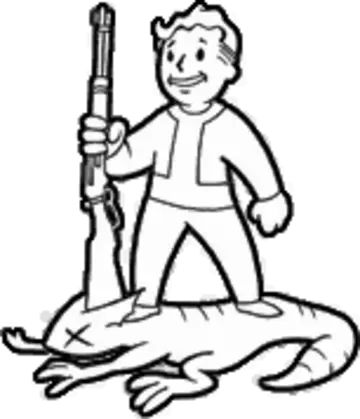
“What are they eating, when they’re not eating you?”
GAME (AMBIENT) CREATURES
"It's okay to eat them. Everything else out here does."
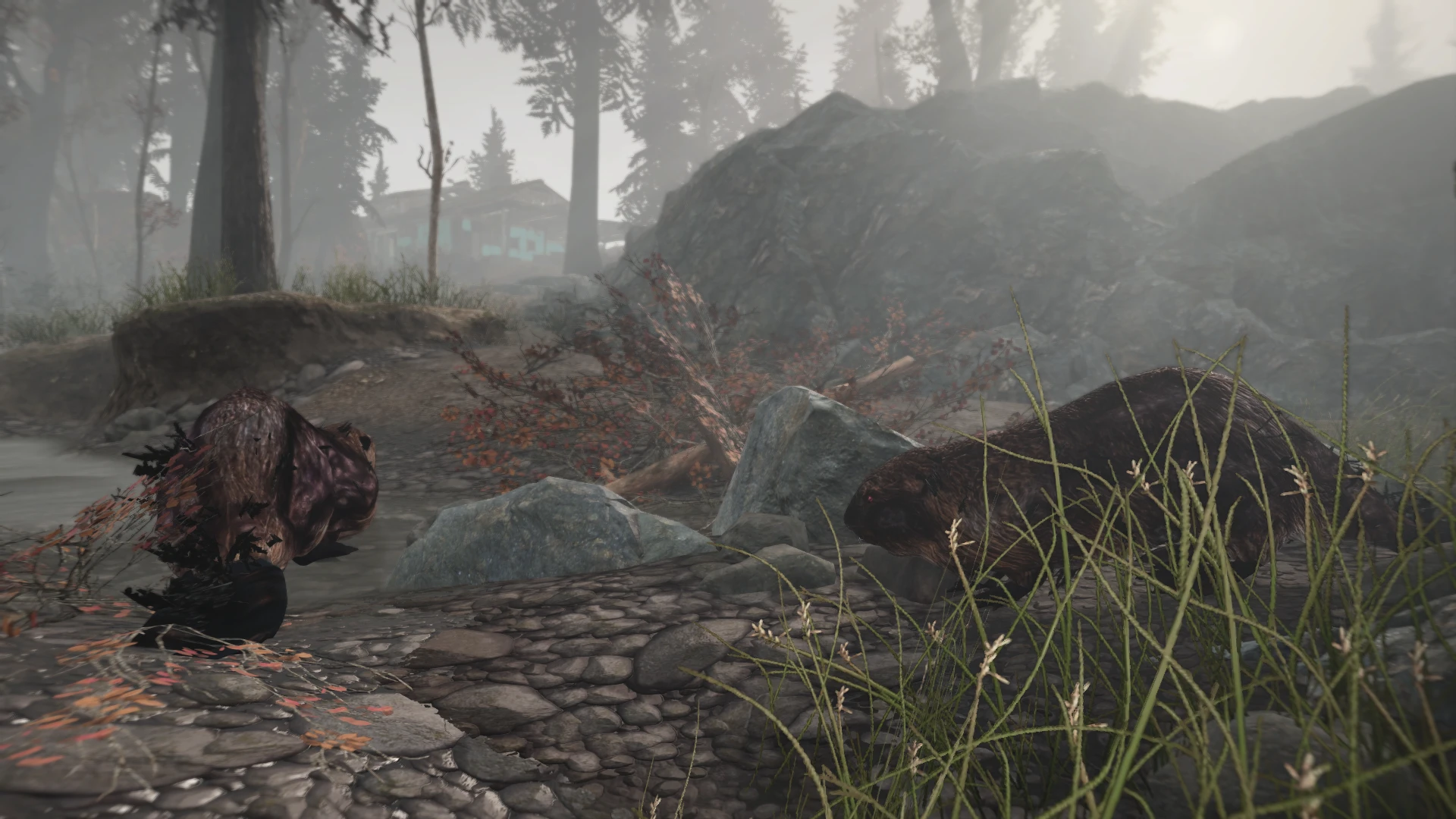
Beavers
"They must just be in pain - all the time."
Beavers haven’t seen drastic changes since the Great War –other than the notable addition of protruding spikes and bone spurs littering
their bodies. These water-loving varmints roam the shores of lakes and rivers, avoiding
contact with humans and predators as much as possible. When cornered, however,
they may attempt to strike out at their assailants before fleeing for safety –
so watch your hands!
Beavers are a reliable source of bone and varmint meat.
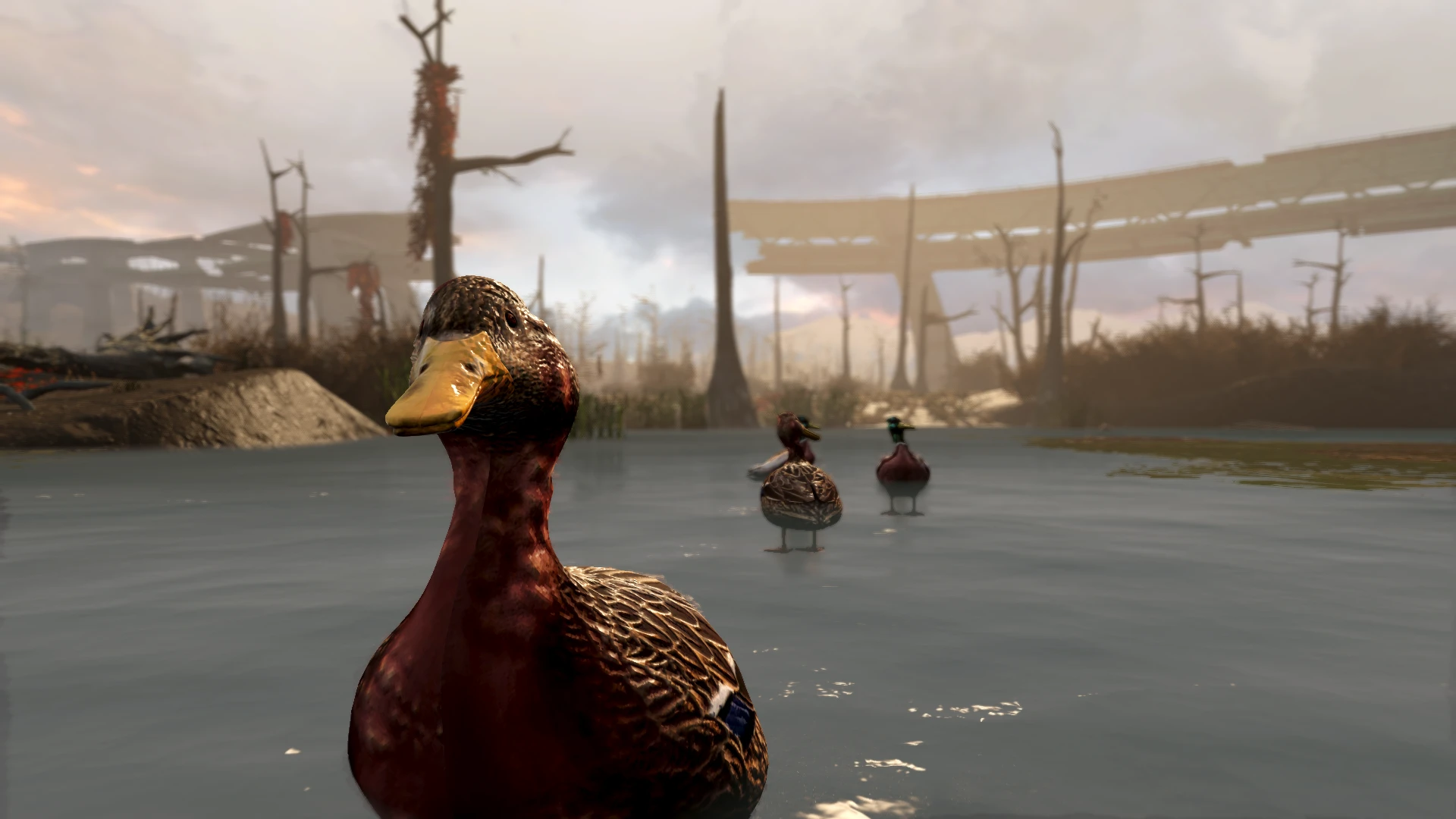
Ducks
"Apparently these things could fly before the war?"
Ducks haven’t seen their waterside lives change much in the centuries following the Great War. Generations of heavy radiation have caused
many of these Commonwealth waterfowl to suffer significant feather loss, resulting
in the loss of their capabilities for flight. Those that can do so maintain
annual migration patterns, while the majority that cannot are forced to remain
in the Commonwealth year-round – where they make ideal prey for hunters and
predatory mutants.
Ducks are a reliable source of meat and various waterborne components, like oil and nuclear material, that adhere to their feathers while
swimming.
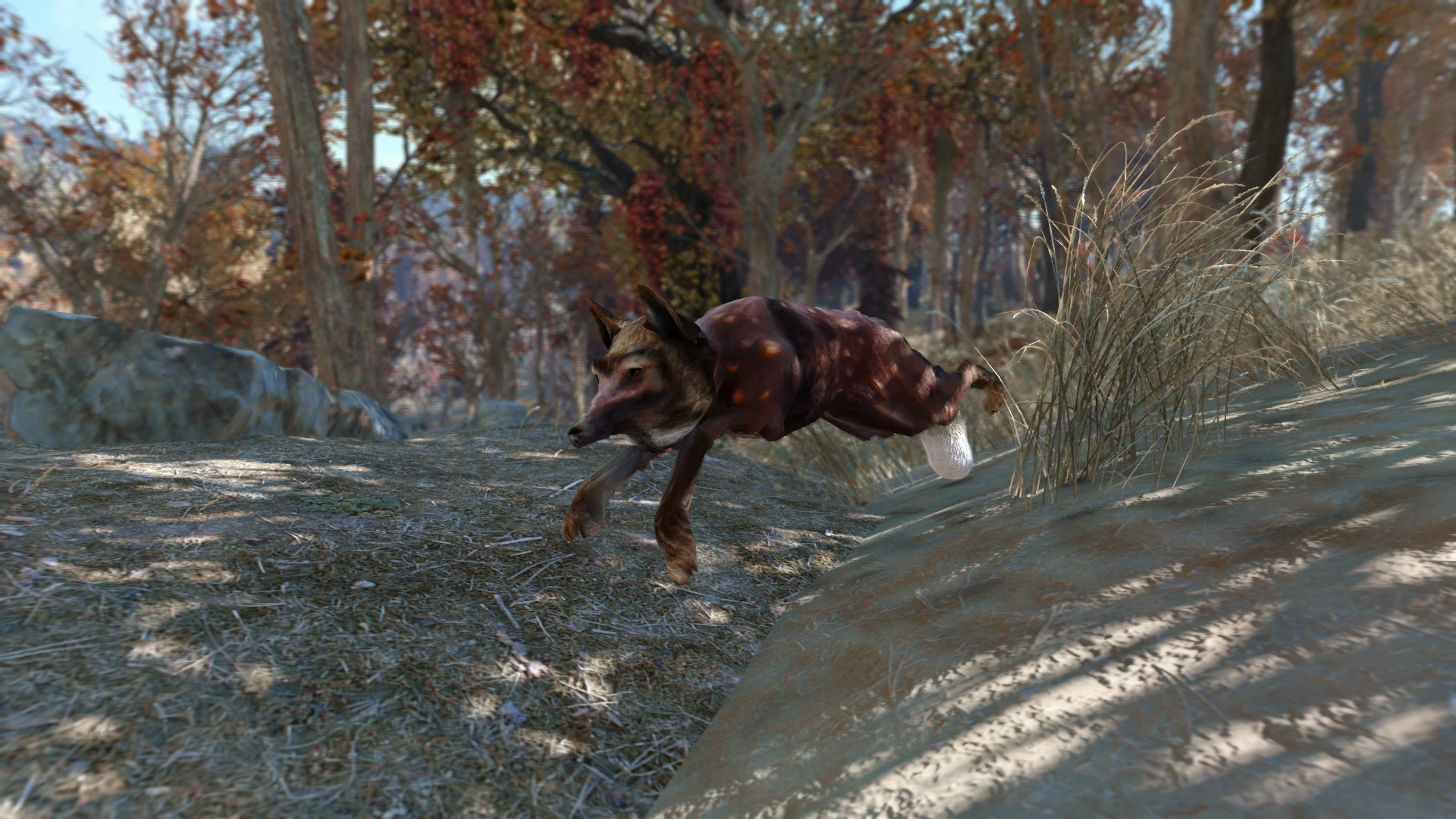
Foxes
"They’ve seen better days."
Foxes in the wild appear emaciated and lacking in much of their fur. Most of their physical deformities are attributed to minor mutations
and the frequent radiation poisoning that is common in most animals throughout post-war
America. Despite their appearance, however, foxes are fast and agile – bolting
whenever a threat makes itself known.
Foxes are a reliable source of prime varmint meat – if you can catch them.
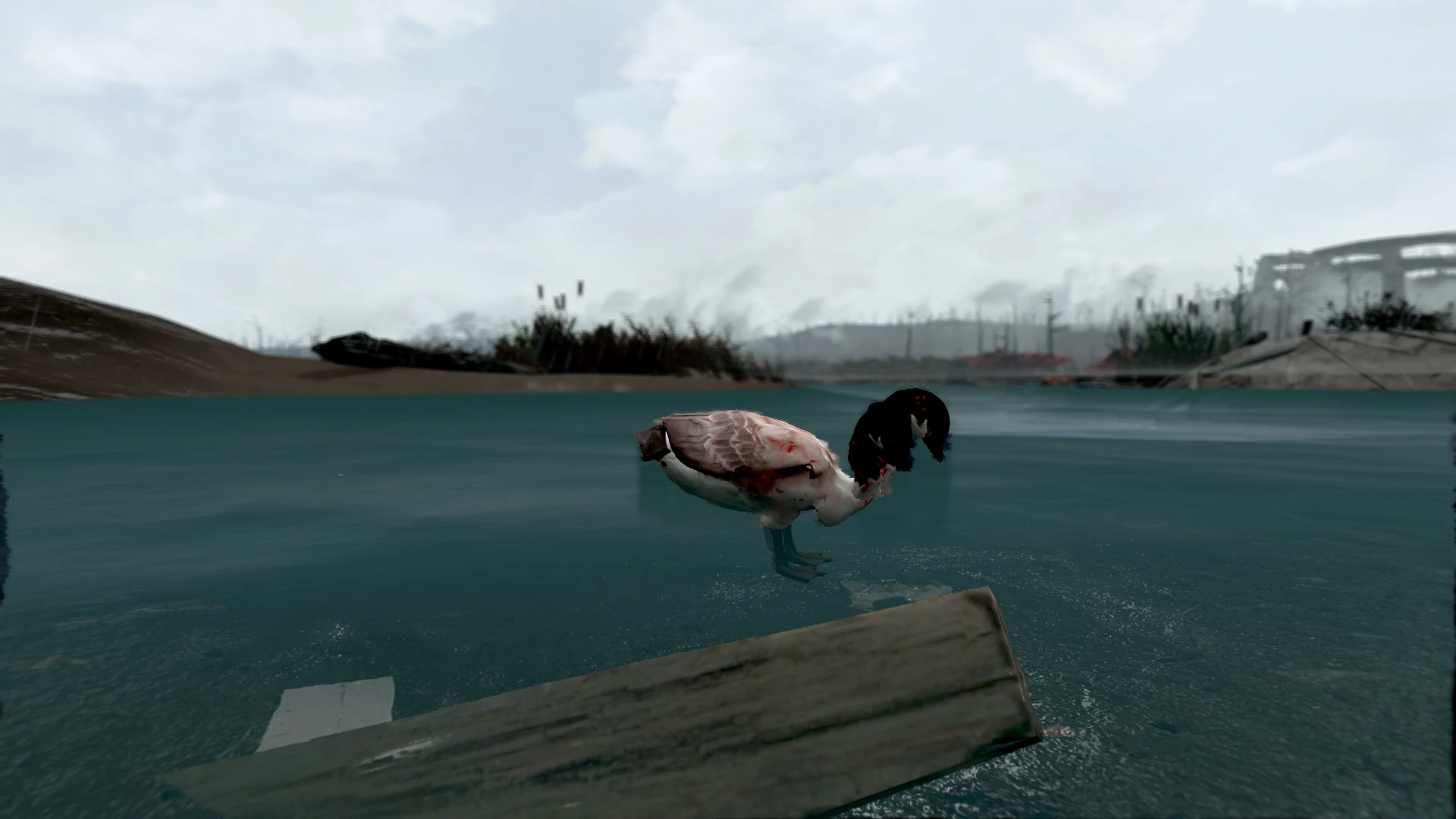
Geese
"Hissin', honkin', hydras of hate."
Geese are found throughout the Commonwealth - primarily near water sources. Many geese, like other waterfowl, have experienced severe feather loss due to their extended exposure to highly irradiated water sources - rendering many flightless. In the wake of the Great War, the canadian goose also experienced another particularly severe mutation in their additional heads - three, to be exact. Geese tend to act exactly like their pre-war counterparts, and are a good source meat for a hungry wastelander.
Geese are a great source of poultry meat and mischief.
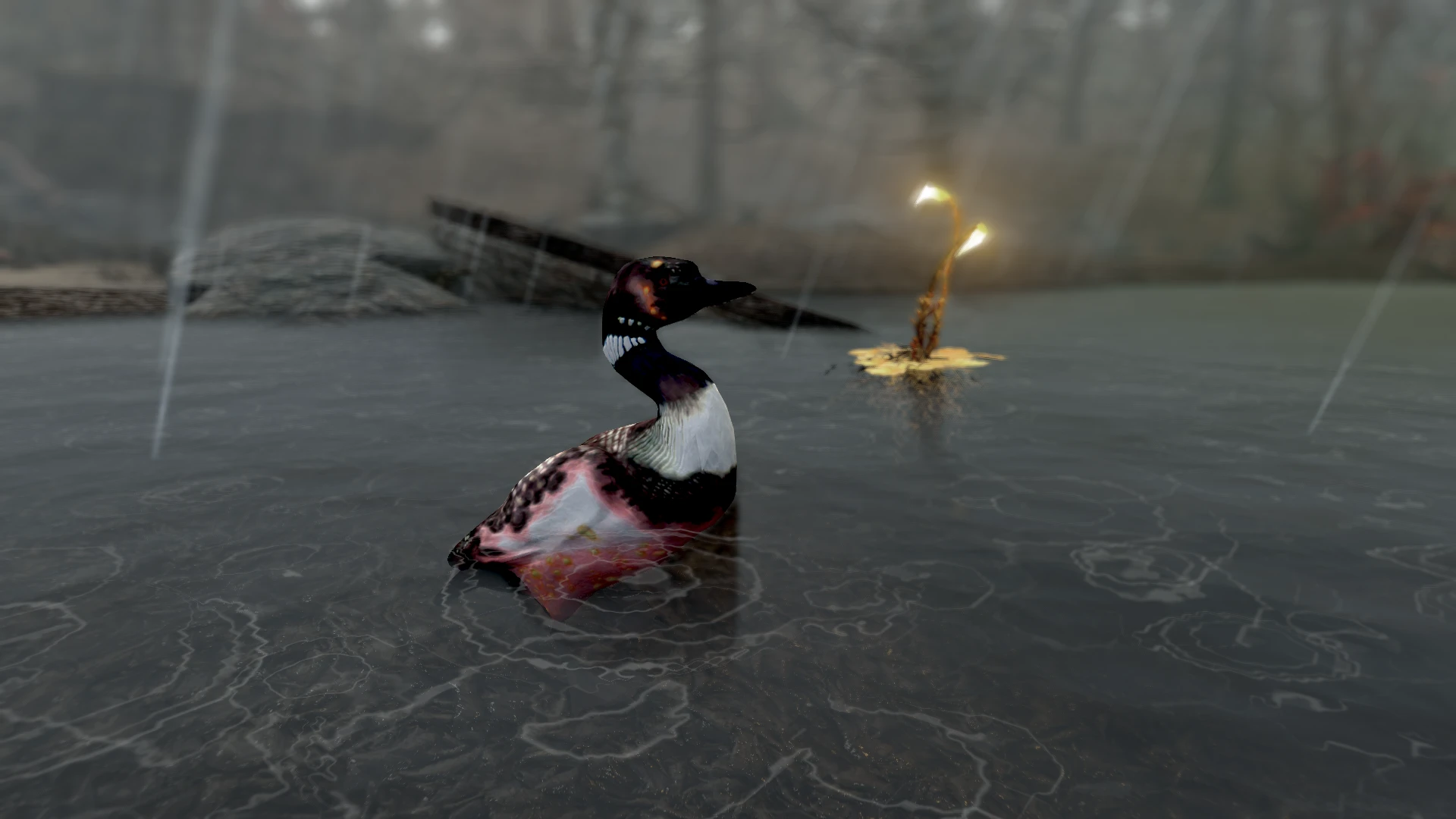
Loons
"The spooky swamp bird lives on."
The common loon is iconic for the eerie, echoing song it produces. Like other waterfowl of post-war America, many loons have experienced feather loss and loss of flight. Ironically, their remaining feathers are a primary reason why they are hunted - as even flightless loons have retained more feathers than most other waterfowl. The haunting call of the loon can be heard throughout the Commonwealth's wetlands - matching the ominous nature of such wild, untamed wildernesses.
Loons are a consistent source of feathers, poultry meat, and creepy noises.
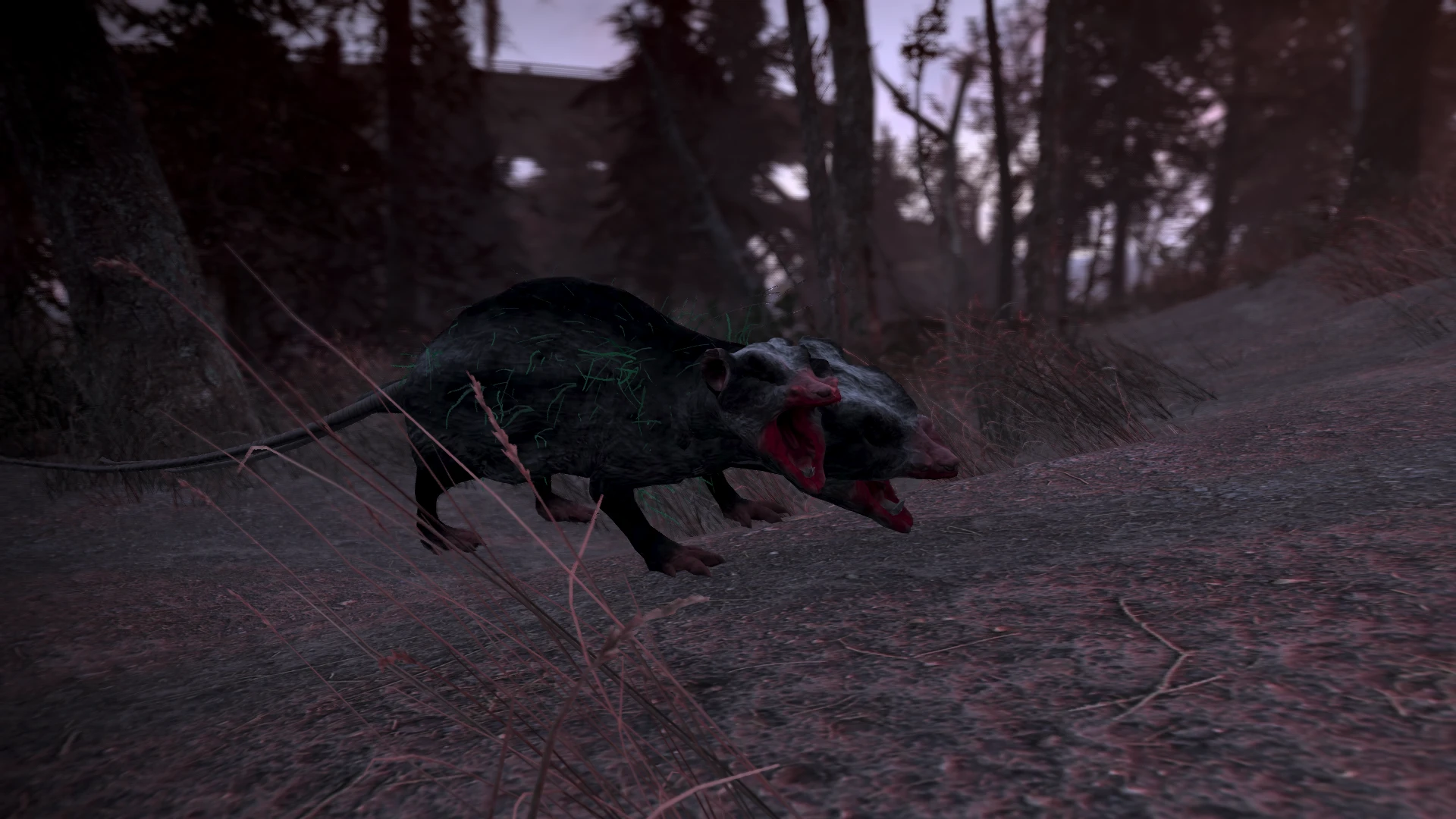
Opossums
"They may be harmless, but I don't want em' near me. It DEFINITELY has something to do with all those heads. Namely how they all seem to smile at once..."
Opossums haven't changed much since the Great War - outside of the many appendages. Like radcoons, they are primarily scavengers. Opossums in the Commonwealth have been found with stomachs full of junk and trash that the creatures couldn't possibly digest, leading some wasteland biologists to wonder if these opossums have somehow lost their impulse control - or some other biological inhibitor that would normally prevent animals from consuming what would normally be considered inedible garbage. Regardless, opossums are quite harmless - despite their horrific appearance. Their multi-pronged tails, peculiarly enough, are thought to be a lucky charm among Commonwealth locals. Consuming one is thought to bring good fortune - if you can stomach it.
Opossums are a reliable source of varmint meat and miscellaneous junk.

Pheasants
"Suddenly, I’m famished."
Pheasants are rare in the Commonwealth, often found far from civilization or prewar ruins. Though they appear irradiated and partially featherless like many of the Commonwealth’s bird species, their meat quality is immaculate. For this reason, they are prized by hunters and chefs alike as a delicacy
worth tracking to the edge of the wasteland to find. Pheasants tend to roam the northwestern forests of the Commonwealth, where the underbrush remains thick and human foot traffic low.
Pheasants are a reliable source of plump bird meat and rare eggs.
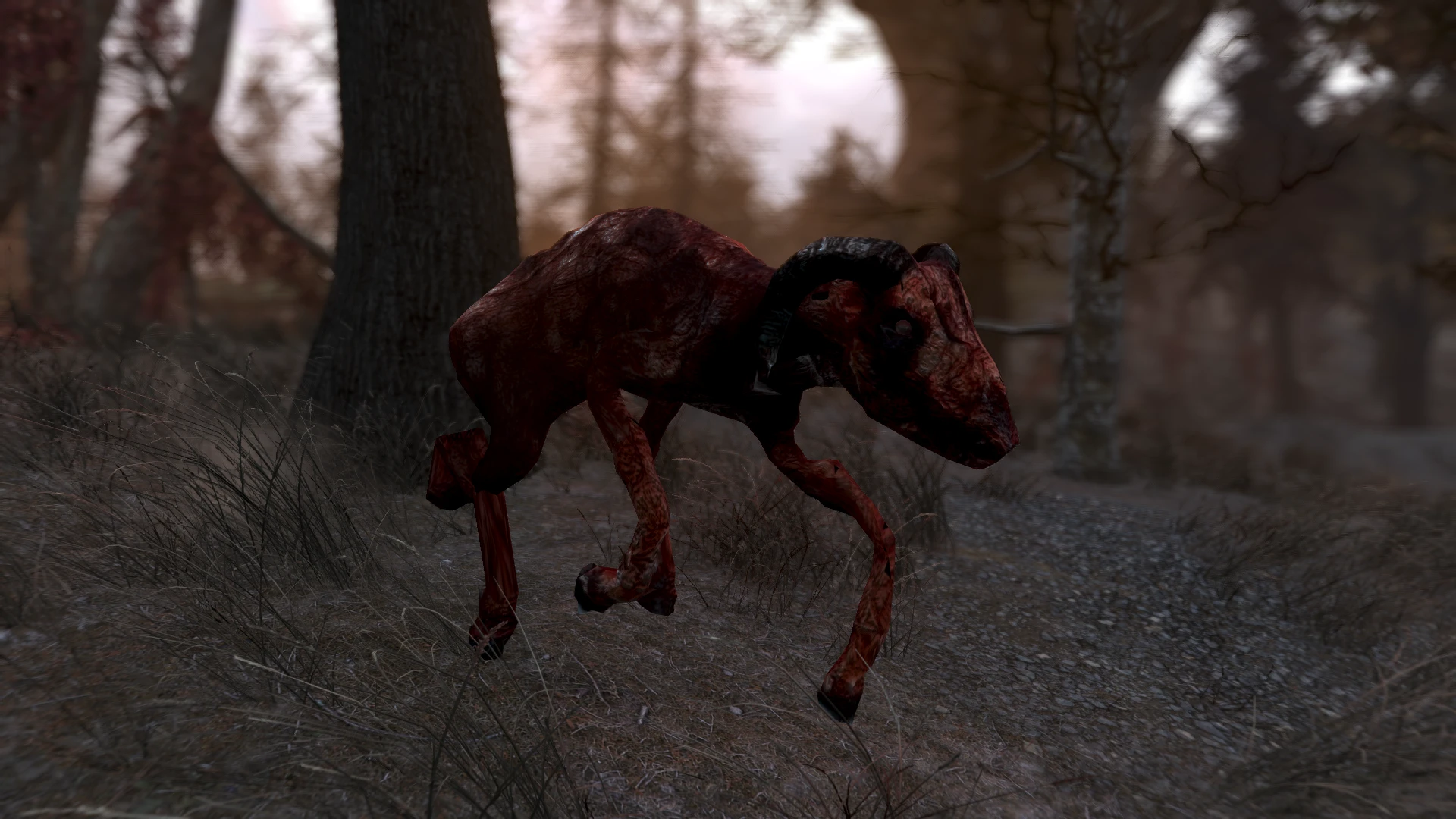
Radhoners
"Better to just put ole Black Phillip out of his crispy, irradiated misery."
The billy goat was commonly found throughout the Commonwealth as livestock before the war. Like their cousins, the bighorners of southwestern America and the sheepsquatches of the midwest, radhorners have seen drastic mutations in the time since the bombs fell. Radhorners resemble shambling, burnt corpses - in a way not dissimilar to feral ghouls. Despite their appearance, wild radhorners are harmless and will flee if provoked. A radhorner's milk is almost as coveted as that of the brahmin, though radhorners are much harder to train as livestock than the latter. As such, the easiest way to attain this delicacy is, as always, through force.
Radhorners are a consistent source of both big game meat and highly-coveted radhorner milk.
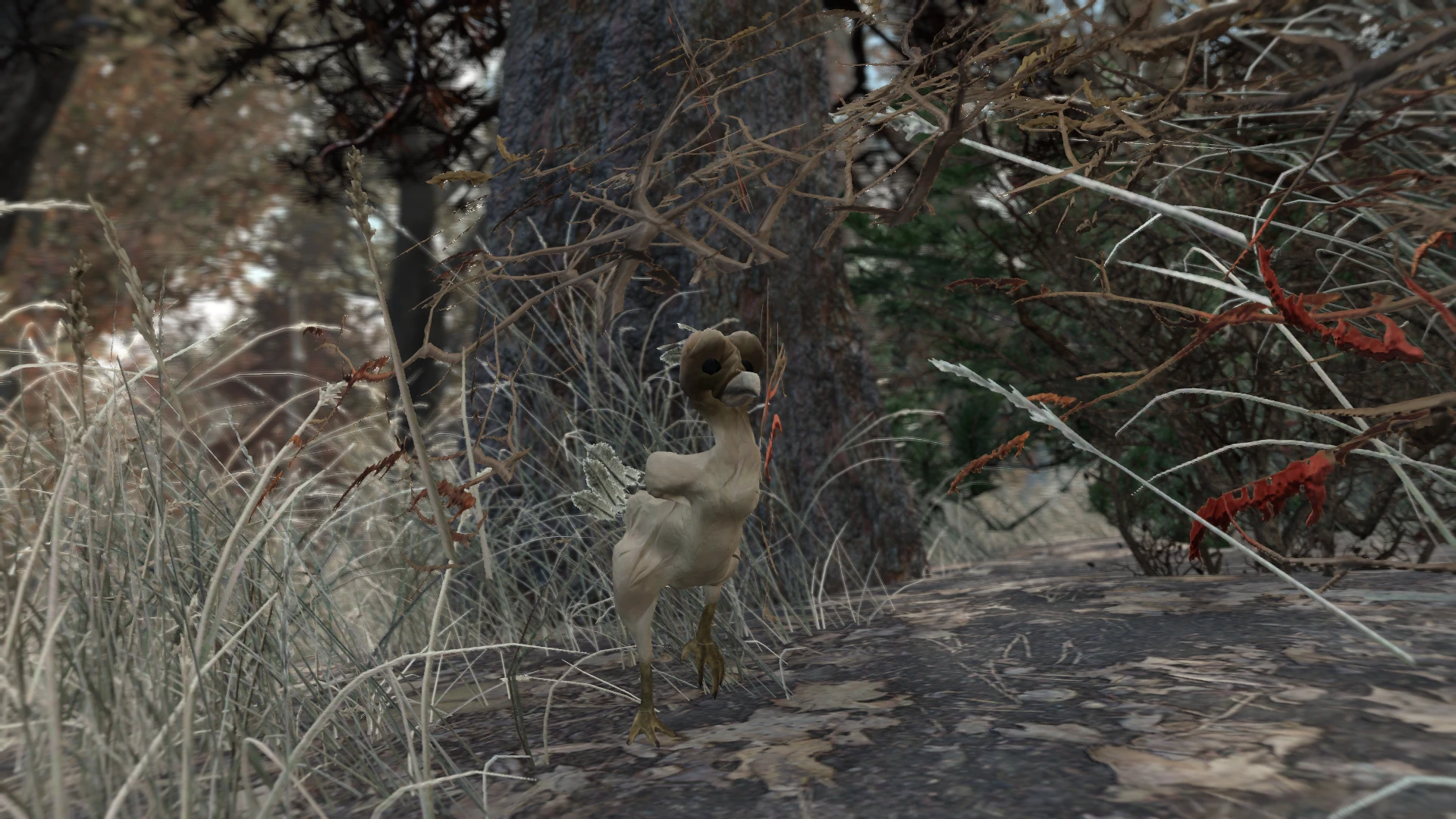
Screech Owls
"The little blighters' beak music always freaks me out."
The common screech owls of Massachusetts suffered extreme feather loss in the wake of total atomic annihilation. They've been reduced to flightless wanderers - scurrying through the underbrush as they fill the nuclear autumn woods with their unique brand of calming, yet haunting, music. The few feathers that remain on the backs of screech owls tend to be hardier, more heavily affected by the elements, and higher in component value than that of most other birds. For this reason, screech owls are often hunted by collectors.
Screech Owls are a reliable source of bird meat and rare feathers.
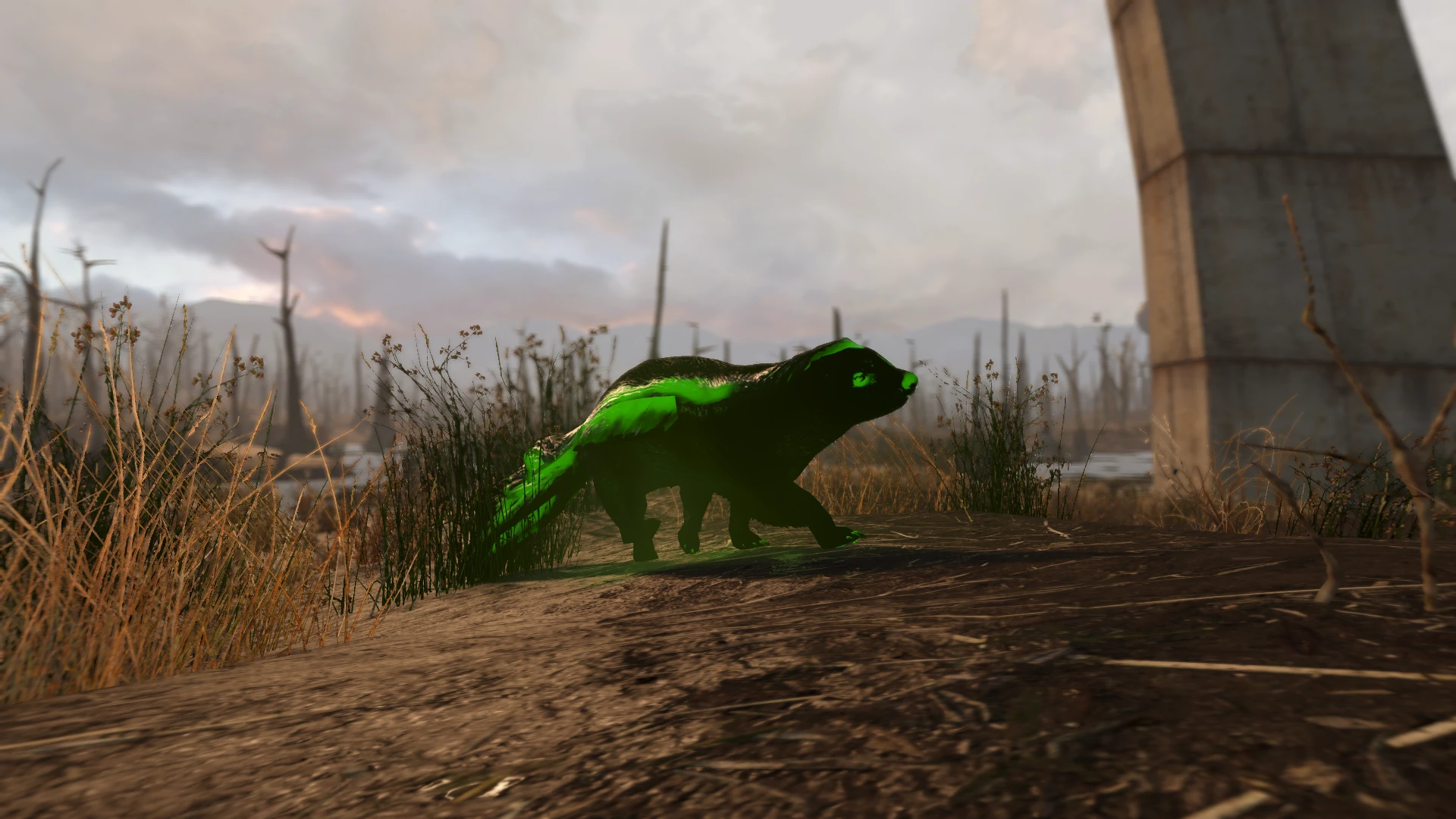
Skunks
"Light bulbs with legs."
Skunks of the wasteland are a strange phenomenon. They havemaintained all of their fur and features, yet sport a now-iconic radioactive
glow that gives them an otherworldly appearance. Skunks in the Commonwealth are
rare and incredibly fast, bolting off into the sunset at the slightest hint of
trouble. They are highly sought-after prey for career hunters in the wasteland.
Skunks are a precious source of irradiated and ionized meat, nuclear material, and irradiated blood. Gun one down before it can escape and
you will be greatly rewarded.
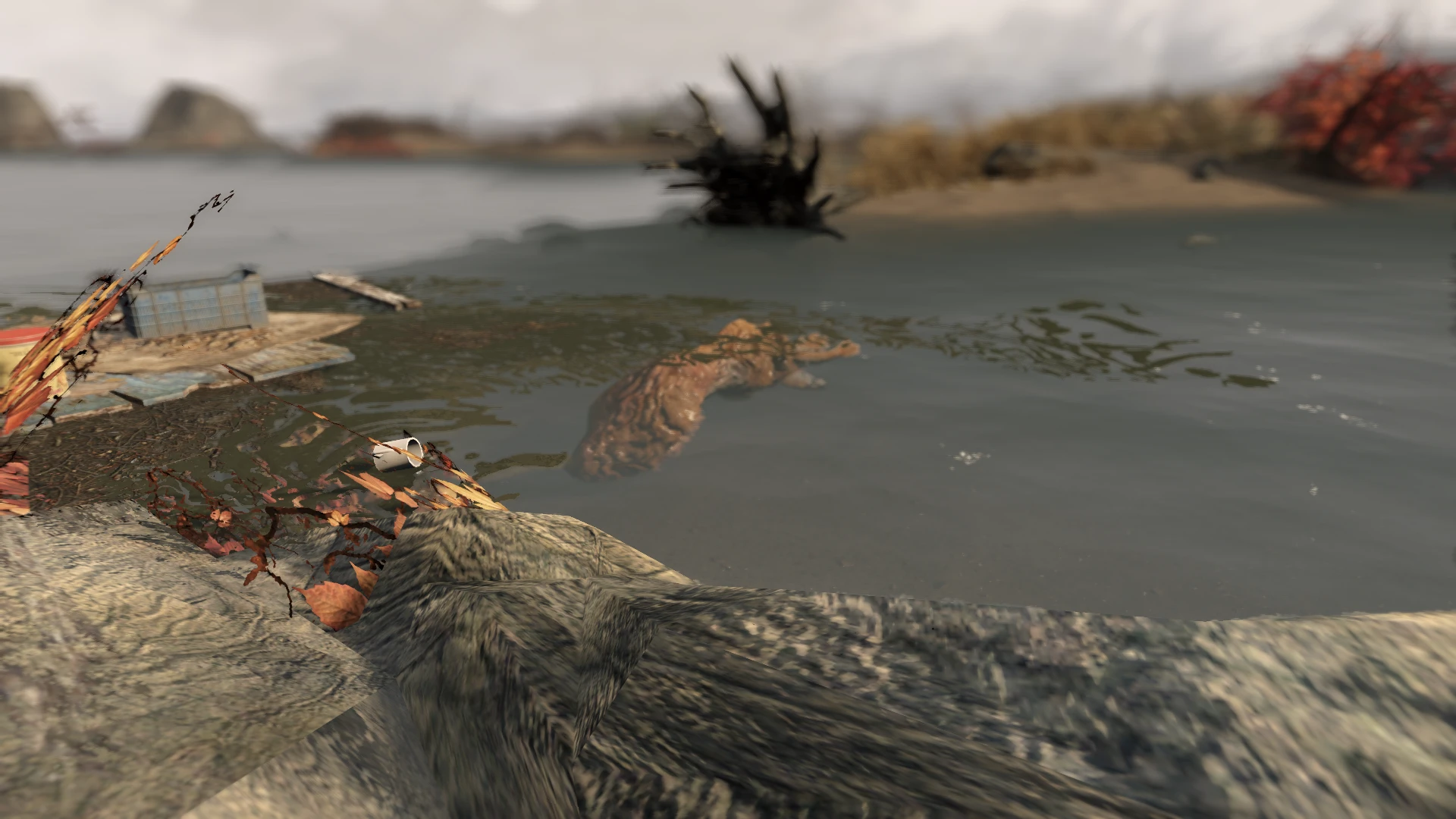
Squids (As Seen in Aquatic Bestiary)
"Apparently there was a time when it WASN'T normal for the brains to be on the outside..."
Strange mutant squids with lumpy, squishy, brain-like exteriors are known to roam the coastal waters of the Boston area. Thought to have mutated from either the shortfin or longfin species of squid commonly found in New England, the Commonwealth’s giant mutant squids are strange and skittish
beasts. They are also partial to deep water and ocean trenches, meaning finding them is almost as difficult as actually hunting them.
Squids are a reliable source of fish meat, oil, and acid.
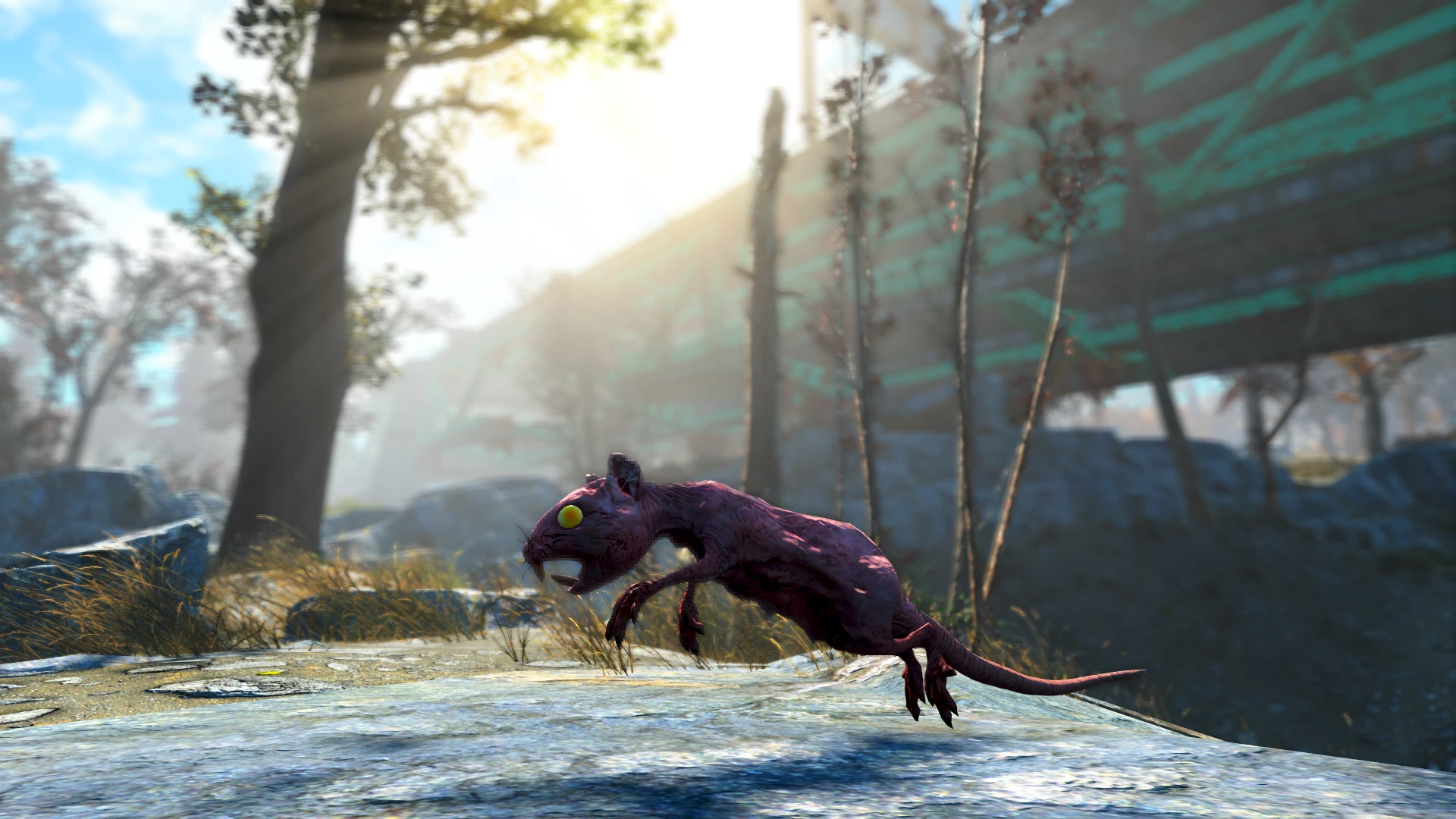
Squirrels (Squirrels of the Commonwealth)
"Damn, those things are fast!!"
Squirrels, also called radsquirrels, have lost retained their size in correlation to pre-war squirrels. They have suffered total hair loss, however, and now have malformed, bulbous eyes. The squirrels of the Commonwealth are known for one primary trait in particular - their speed. Spook em', and they'll be gone in the blink of an eye!
Squirrels are a prevalent source of, as you might've guessed, squirrel meat!
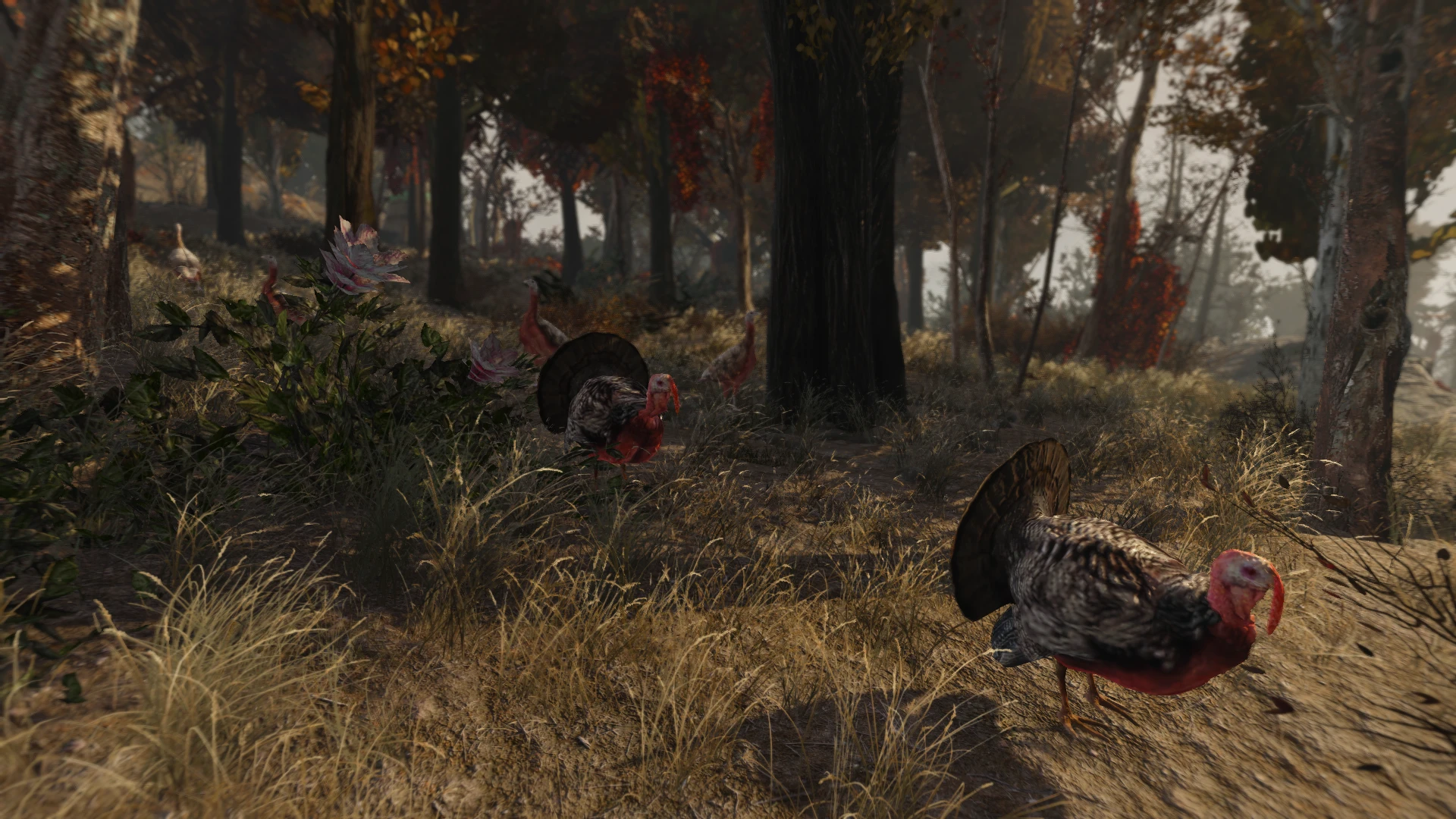
Turkeys
"Well, everything really worked out for them in the end, didn’t it?"
In the wake of the world’s ending, turkey populations couldn’t be better. Though most have suffered minor mutations over the years, the
two-centuries-long dark age that followed total atomic annihilation has allowed turkey populations to grow almost entirely unchecked. Though some may fall prey to mutants and the odd wastelander, thriving groups of turkeys can be found roaming all over of the Commonwealth.
Turkeys are a reliable source of bird meat and feathers.
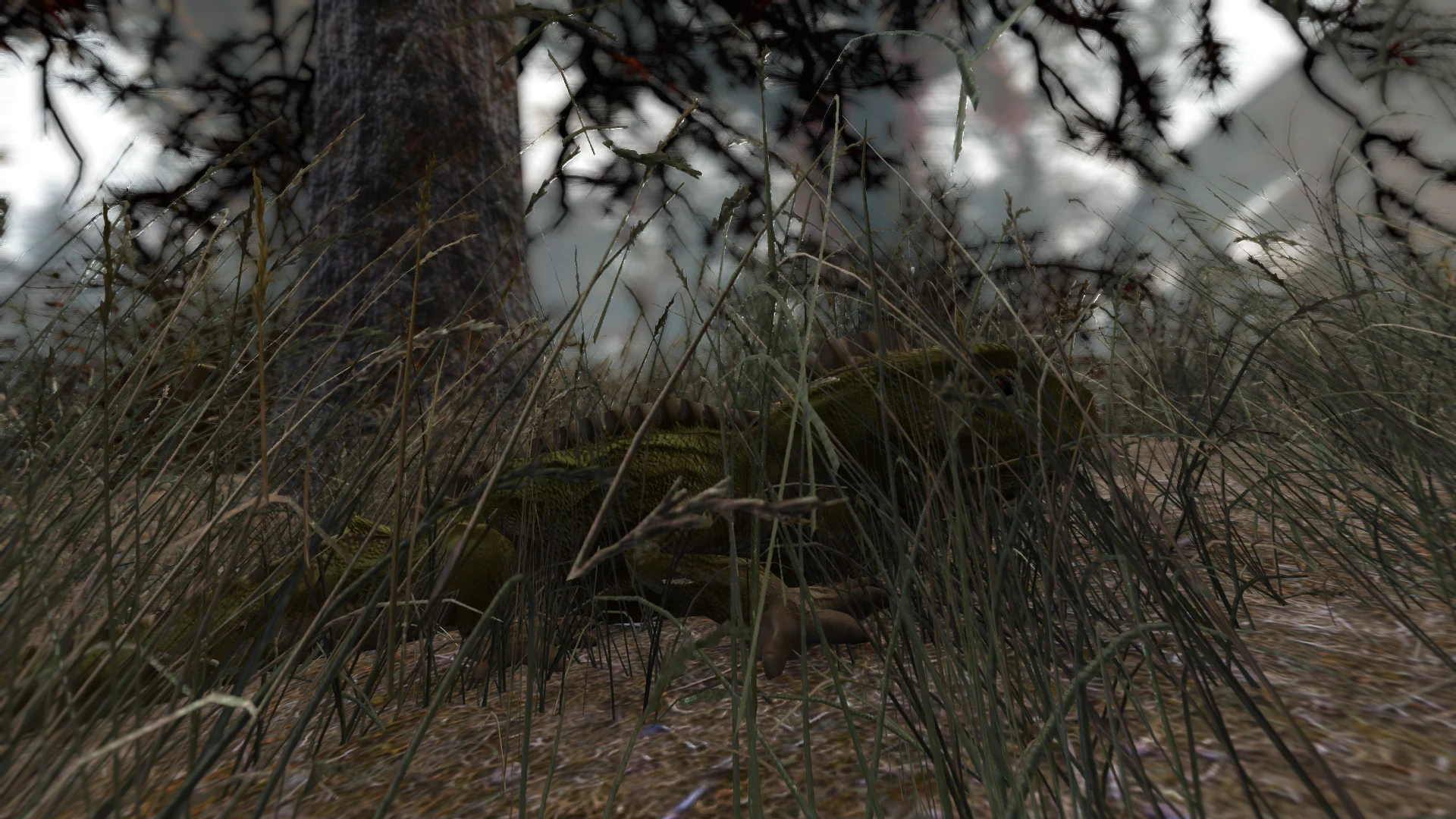
Wasteland Iguanas
"How can the waste folk not feel bad for skewering em' on sticks? They never did nothin' to nobody!"
Iguanas are a famous little critter throughout post war America. Once a household pet, they now wander the wastes in droves. They're such a common food source, in fact, that often traders and butchers are known to disguise certain, and far more questionable, meats as iguana. This has given certain dishes made from the critters a bad name in various places. Despite the rumors of cannibalism, iguana meat is actually a fair-quality food source. Iguanas are highly docile, herbivorous reptiles that are commonly found everywhere - having taken to the wasteland much more naturally than many other animals found in the Commonwealth.
Iguanas are a reliable source of both herptile meat and iguana meat.

Ghoul Whales
"Their size is only rivaled by their mystique!"
There are murmurs throughout the Commonwealth and other areas of New England of gigantic, ominous creatures that stalk the deep of the post-war Atlantic. These "Ghoul Whales" as they're called, are said to be true sea monsters - wreaking havoc across the coast and swallowing ships that dare sail from the relative safety of the Commonwealth's coast. In reality, the mutant humpback whales of New England are largely docile - only attacking if provoked and/or agitated. Their ghastly appearance, however, cannot be understated. The most famous of these creatures is the mythical Ol' Peg, a blue ghoul whale said to stalk the Boston Harbor. These rumors, however, are largely unsubstantiated.
Ghoul Whales, if you can manage to not only find but kill one, are a source of large amounts of meat and oil.
DISCLAIMER: As a side effect of model scaling in Outfitstudio to reach the sizes outlined in the lore, whales are larger than their hitboxes/collision mesh. This can cause a number of oddities when interacting with them in-game - especially during combat. This is the best I can do with the resources and knowledge I have, however, and the model was too good not to get in the game.
Other Ambient Creatures Added using Dynamic Spawns:
- Brahmin (Fallout 4)
- Cat (Fallout 4)
- Radchicken (Far Harbor)
- Radrabbit (Far Harbor)
- Radstag (Fallout 4)
HYBRIDS
"AKA the ones that might NOT kill you on sight!"
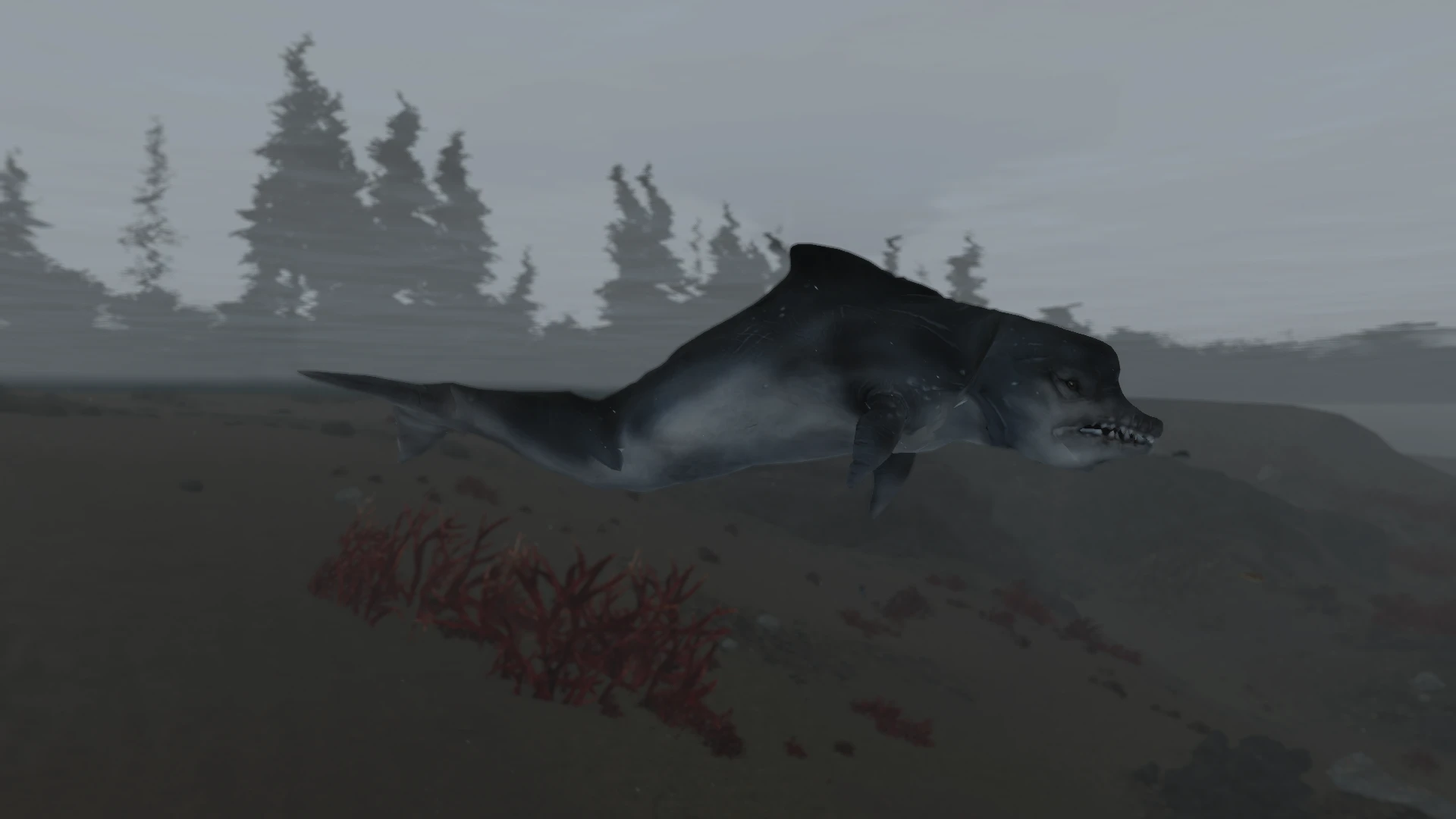
Dolphins (Aquatic Bestiary)
"I miss when dolphins were playful and mischievous critters and not covered in razor sharp teeth…"
Their bloated, rotting corpses line the beaches of New England – a reminder of the terrifying, toothy nightmares that lurk just out of sight. Though not as innately hostile as some other aquatic mutants, dolphins are known to attack those that carelessly trespass into their territory. Clearly not the cheerful, friendly dolphins of old-world memory, most treat these oceanic mammals with caution – and avoid lingering in their waters.
Dolphins are a reliable source of big game meat and oil.
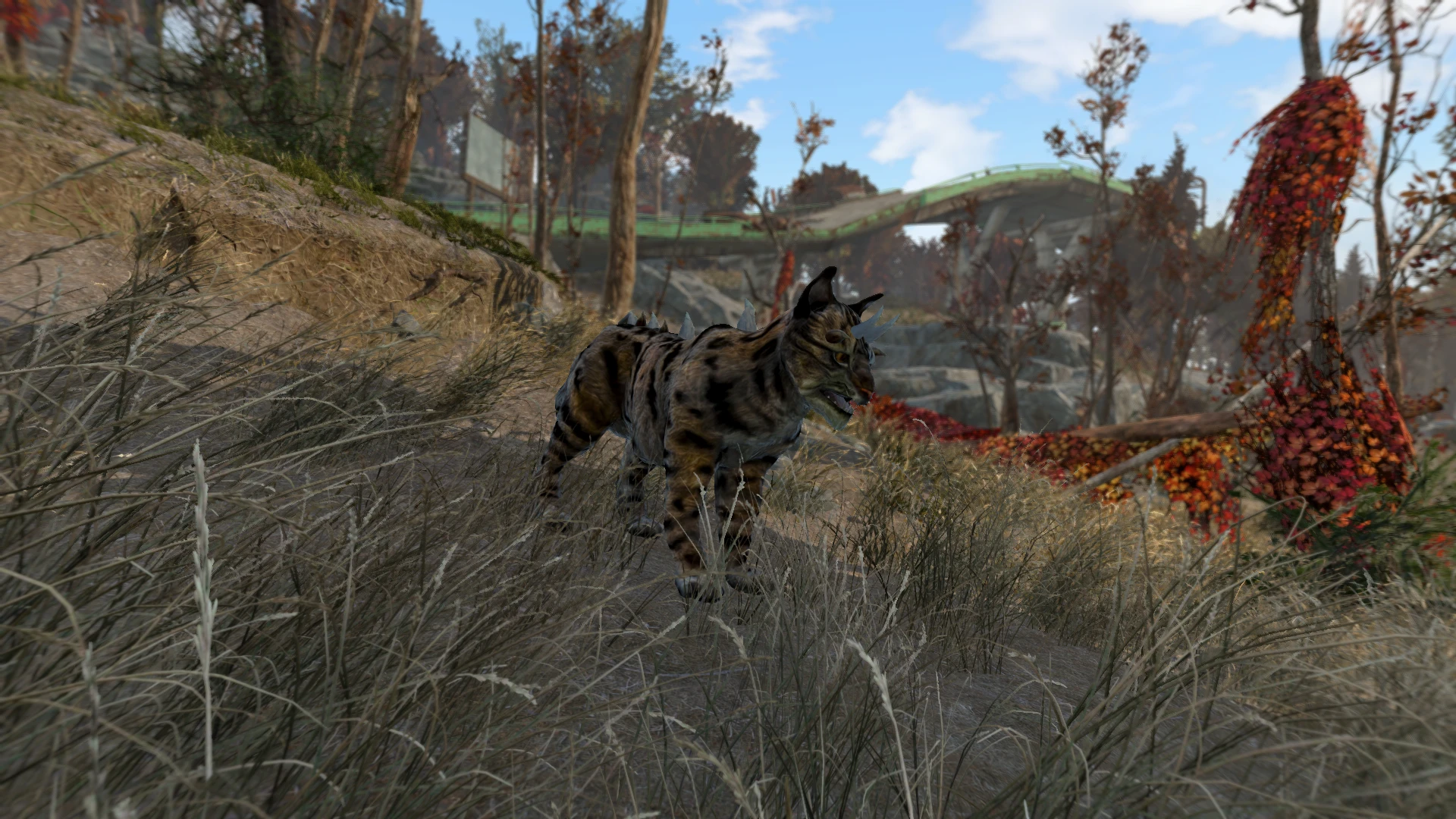
Hellcats
"Further proof that we all died when the bombs dropped and this all is just literal hell."
Hellcats are mutated bobcats that roam the fringes of the wastes. These incredibly rare beasts get their names from the curved horns that’ve sprouted from much of their body. These devilish creatures are as likely to attack on sight as they are to flee, and pack a real wallop when they choose violence. Starry-eyed hunters eager to bag one of these rare cats may find themselves an easy meal if they aren’t prepared for a fight.
Hellcats are a reliable source of bone, big game meat, and cat meat.
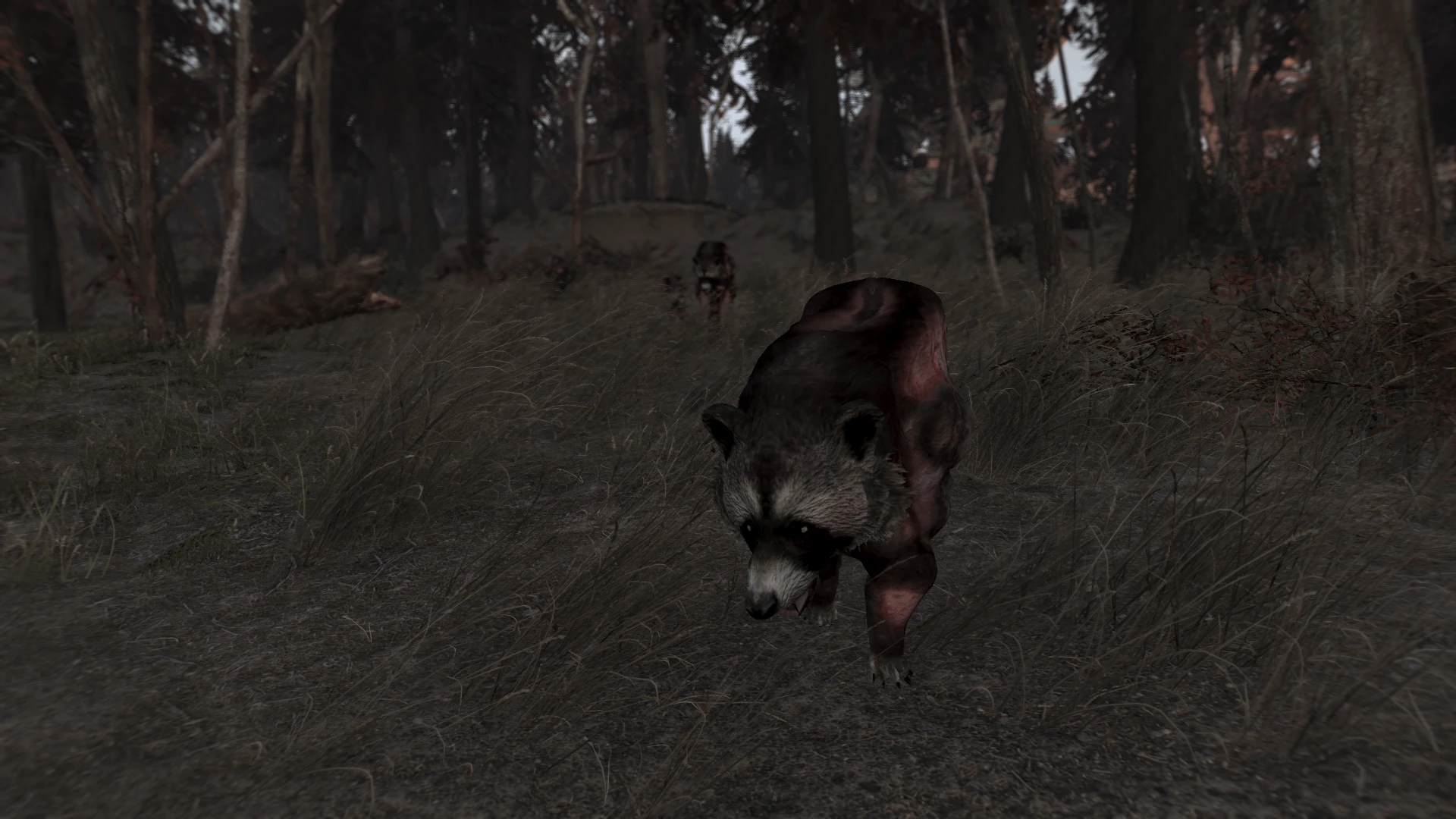
Radcoons
"I’d feel bad for them if they weren’t clearly just living their best lives."
The radcoon is one of the most notorious varmints in the wastes. Radiation has caused heavy amounts of fur loss, giving these blighters a “skinned alive” look. These little troublemakers are a combination of small stature, an appetite for nearly anything, and a bad attitude to create one of the most unique creatures in the Commonwealth. It’s unlikely for a band of these mischievous little critters to pose any real threat to a competent wastelander, but you gotta respect their tenacity for trying. Once that fleeting feeling fades, however, just give one of them a good thump with something heavy and watch the pack scatter off to rethink their plans. Such is the radcoon – a personality far too strong for its body.
Radcoons are a reliable source of varmint meat and junk.
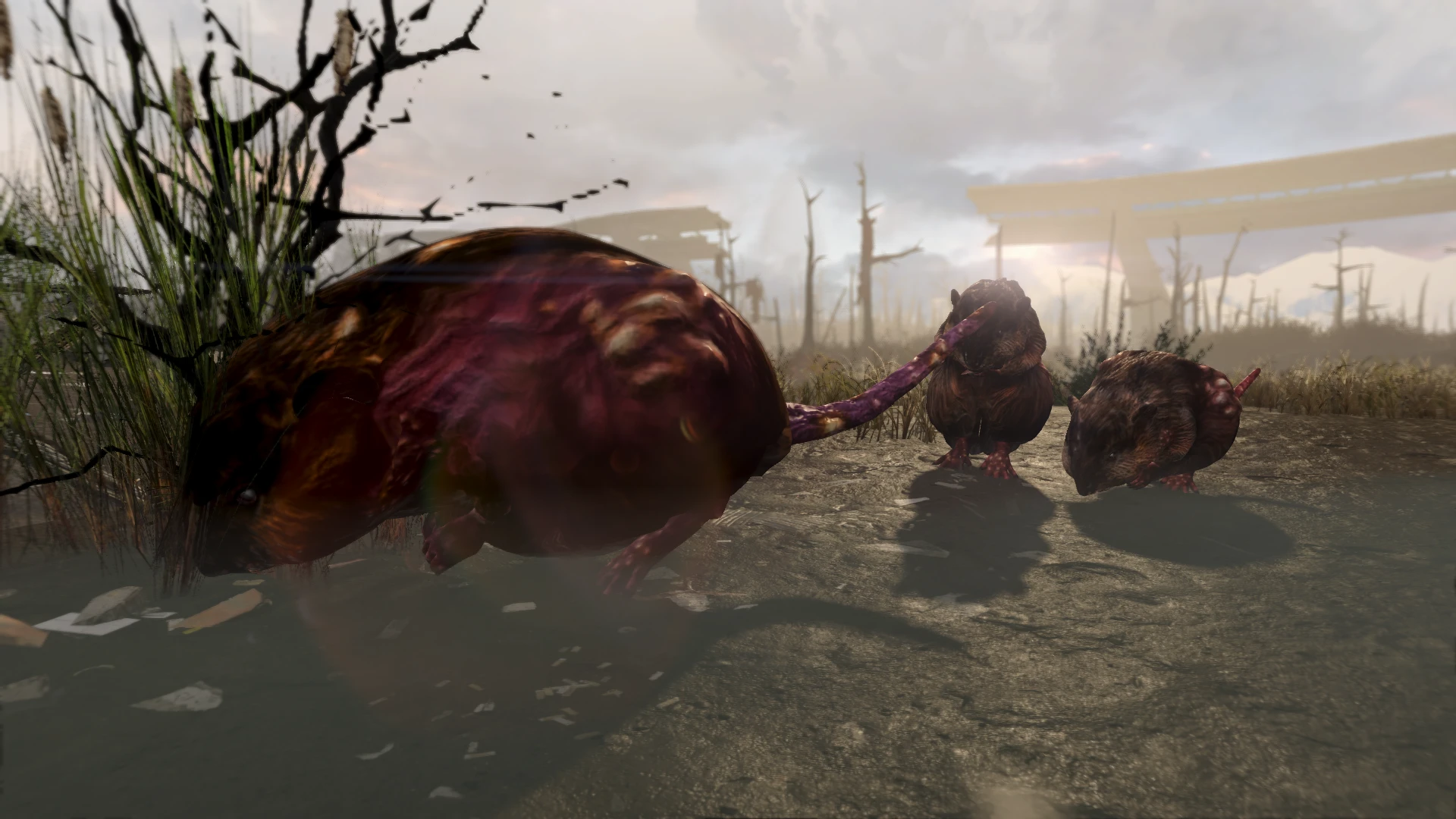
River Rats
"They’re adorable until you remember that they’re virtually indestructible."
When the bombs dropped, muskrats won the lottery. Radiation transformed these tiny waterfront varmints into bloated, bulbous rodents with thick skin and thicker skulls. River rats waddle along the shorelines of freshwater lakes, ponds, and (of course) rivers – chittering and sniffing all the way. They are fairly docile critters, despite their imposing size, and usually only attack when provoked. A pack of angry river rats is a force to be reckoned with, though, and most may wish to simply let these plump ol’ beasties be. Some even claim river rats are a great mirelurk deterrent for post-apocalyptic ecosystems – although this is unverified.
River Rats are reliable source of big game meat.
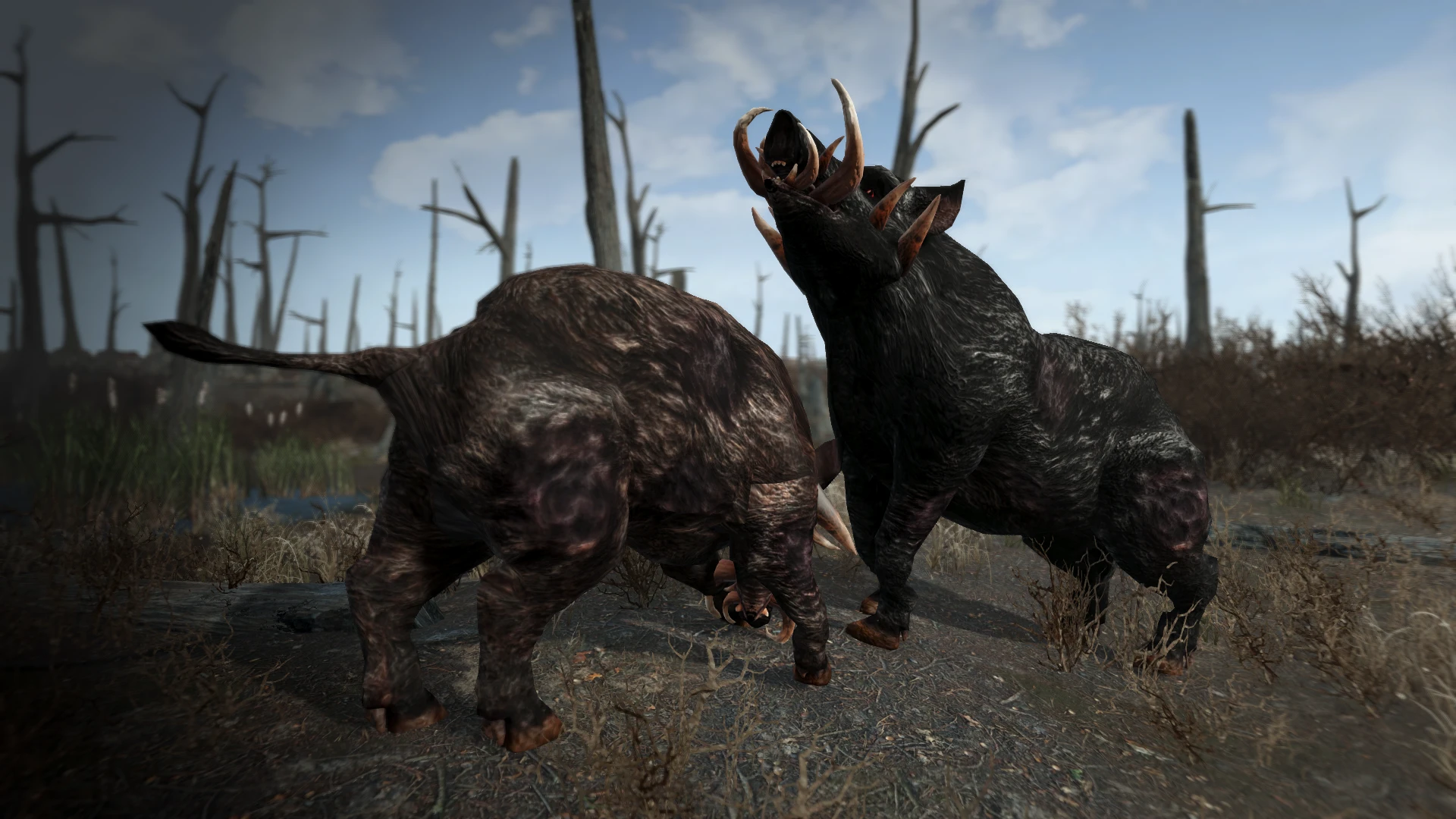
Wild Boar
"Anything that stabs you a dozen times by only goring you once is just too damn pointy."
Invasive species tend to be more resilient in times of crisis than those native to the ecosystem. Such is the case with the Eurasian boar, which responded to total atomic annihilation by growing two sizes bigger and sprout quite a few new pairs of tusks. These beasts are found sparsely throughout the Commonwealth, but are most commonly located in the swamps and marshes south of Boston. Wild boar are easily agitated, meaning it’s best to keep a wide birth if you don’t want to provoke a fight. Cross into their considerably large personal bubble, and you’re sure to regret it.
Wild boar are an excellent source of big game meat.
HEAVY HITTERS
"Trust me, you're more afraid of them than they are of you."
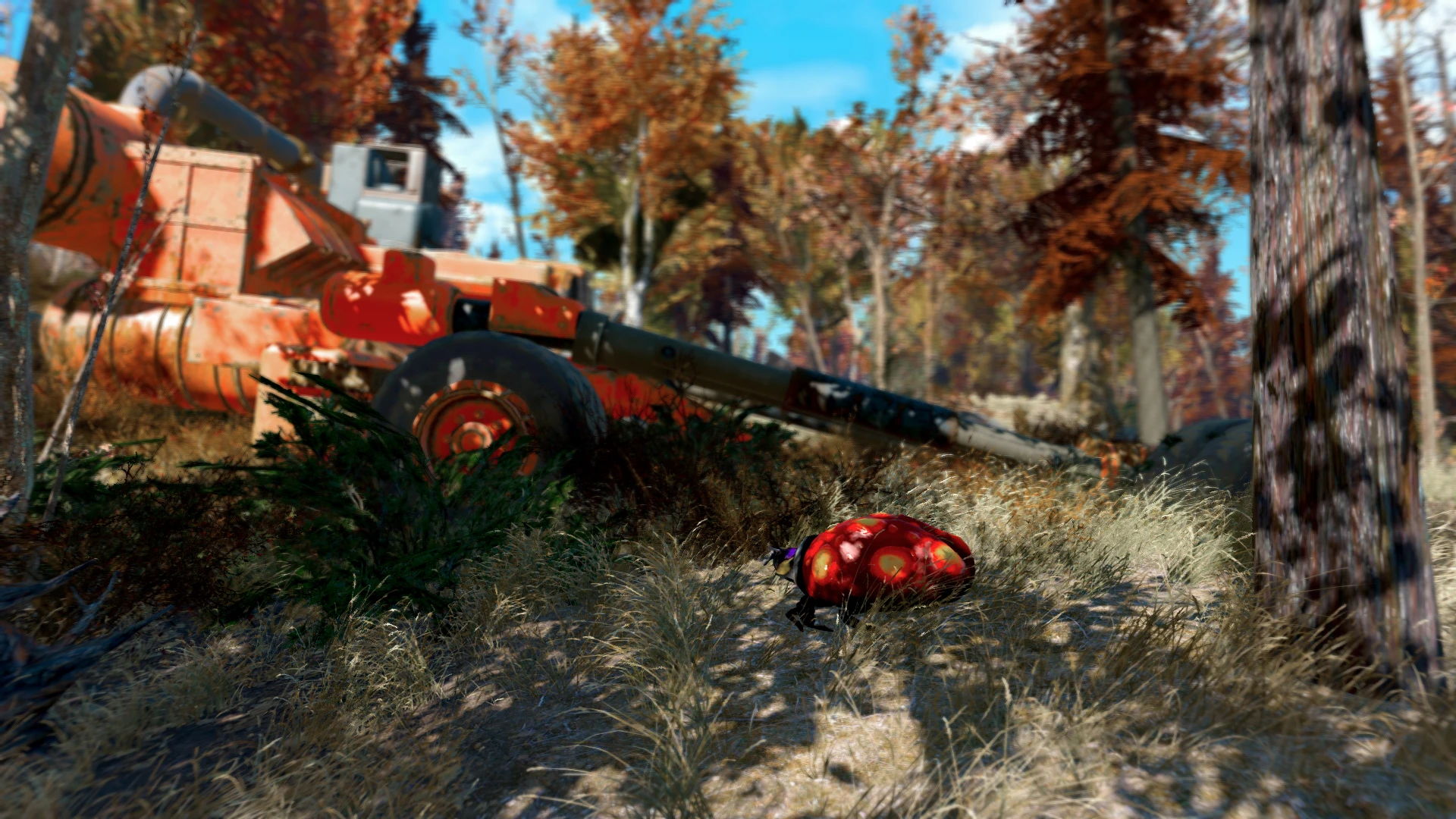
Boombugs
"They’re kinda cute once you get over the fact that they’re walking powder kegs with an insatiable blood lust."
Meet the boombugs – you’re going to hate them. The ladybugs of post-war America have grown much larger, and much more volatile, in the wake of the Great War. These buggers are 50 shades of ornery, pack a mean bite, and have a bloody surprise in store when battered and beaten to a pulp. These six-legged hand grenades are at their worst when on the way out, often causing chain reactions if multiple boombugs go off at once. Be sure to get some distance whenever one of these bad boys looks like they’re about to shed their mortal coil.

Honeybeasts and Mutant Bees
"Well, that’s just death right there, isn’t it? Death slathered in radioactive honey!"
The honeybee of prewar America has had a heck of a time since the end of the world. Losing its flight capabilities and bloating into monstrous, slow-moving masses of honeycomb and fury, the apocalypse certainly did these queen bees dirty. Unfortunately for anything that’s not a honeybeast, these considerably-massive mutant bees are guarded by swarms of much smaller mutant bees - who rely on the massive hive on the Honeybeast's back for survival. Sometimes, a mutant bee that isn't a queen may also mutate and grow. These flying monstrosities - referred to as Spitter Bees - will lob acidic, radioactive honey at anything that threatens their queen. In short, taking on one of these deadly divas requires careful preparation.
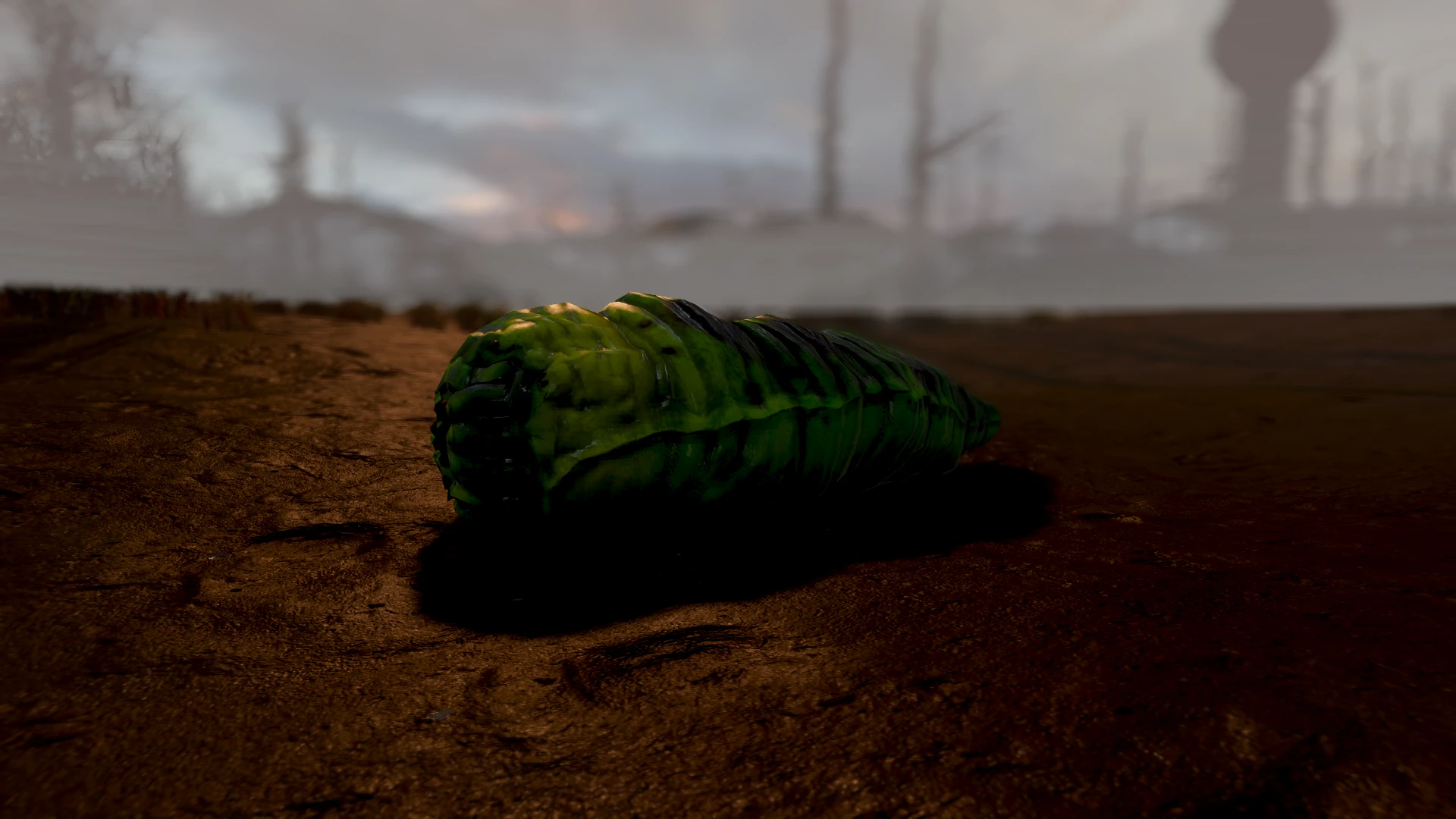
Leeches
"It’s shocking how they, despite all the odds, managed to get even more repugnant!"
Leeches are a scourge in the Commonwealth’s wetlands and swamps. These big bloodsuckers are quick, slippery, and incredibly aggressive – attacking anything that moves. Their vicious bite, regenerative capabilities, ceaseless appetite mean that these sluggers are either despised or feared by every other occupant of the Commonwealth.

Gargoyles
"Wait a minute... you mean THESE are the runts of the family?!"
Gargoyles, also sometimes referred to as radbats, are a rare mutant sourced from the Glowing Sea. They are cousins of the larger, much more dangerous scorchbeast of Appalachia - having both mutated from irradiated bats. While scorchbeasts were further exploited by the nefarious faction known as the Enclave, gargoyles owe their form entirely to heavy radioactivity of the Glowing Sea. As gigantism took hold, the gargoyle's wings became vestigial, while its sonic abilities grew nominally more powerful. Today, gargoyles are a top predator in the Commonwealth - even without the extended mutations or threat of the scorched plague. They may not be the biggest or baddest of their species, but they have earned a place as a legendary heavy hitter in their own right. They haunt the Glowing Sea, promising a swift death to anything foolish enough to cross their path.
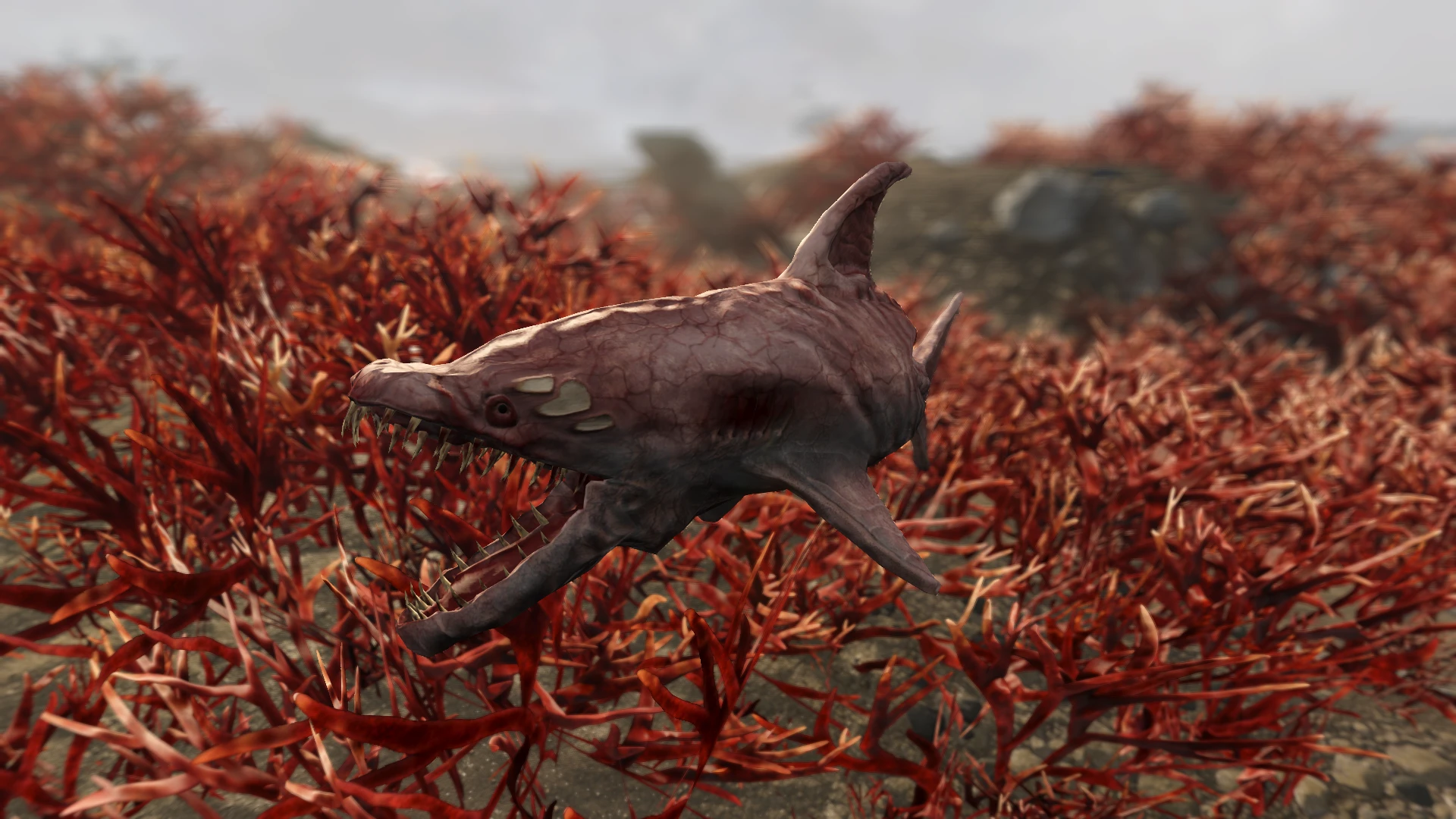
Ghoul Sharks
"Because salty rads ain’t enough of a reason to avoid swimming, apparently."
Ghoul sharks are the eldritch, man-eating sea nightmares that skulk through the radioactive coastline of post-war New England. No one knows exactly which species, singular or plural, of shark evolved into the wicked, vile ghoul sharks we know today, though many theorize most common ghoul sharks originate from the shortfin mako sharks commonly found in New England’s Atlantic waters. The two largest varieties, however, bare a vague resemblance to the white shark and smooth hammerhead, respectively. Regardless, the ghoul sharks that rule the salty, irradiated ocean waters of New England are significantly more bloodthirsty than their prewar predecessors. Any creature that enters their domain can expect to be ripped to shreds by the giant mutant horrors that lurk in the murky, radioactive depths.
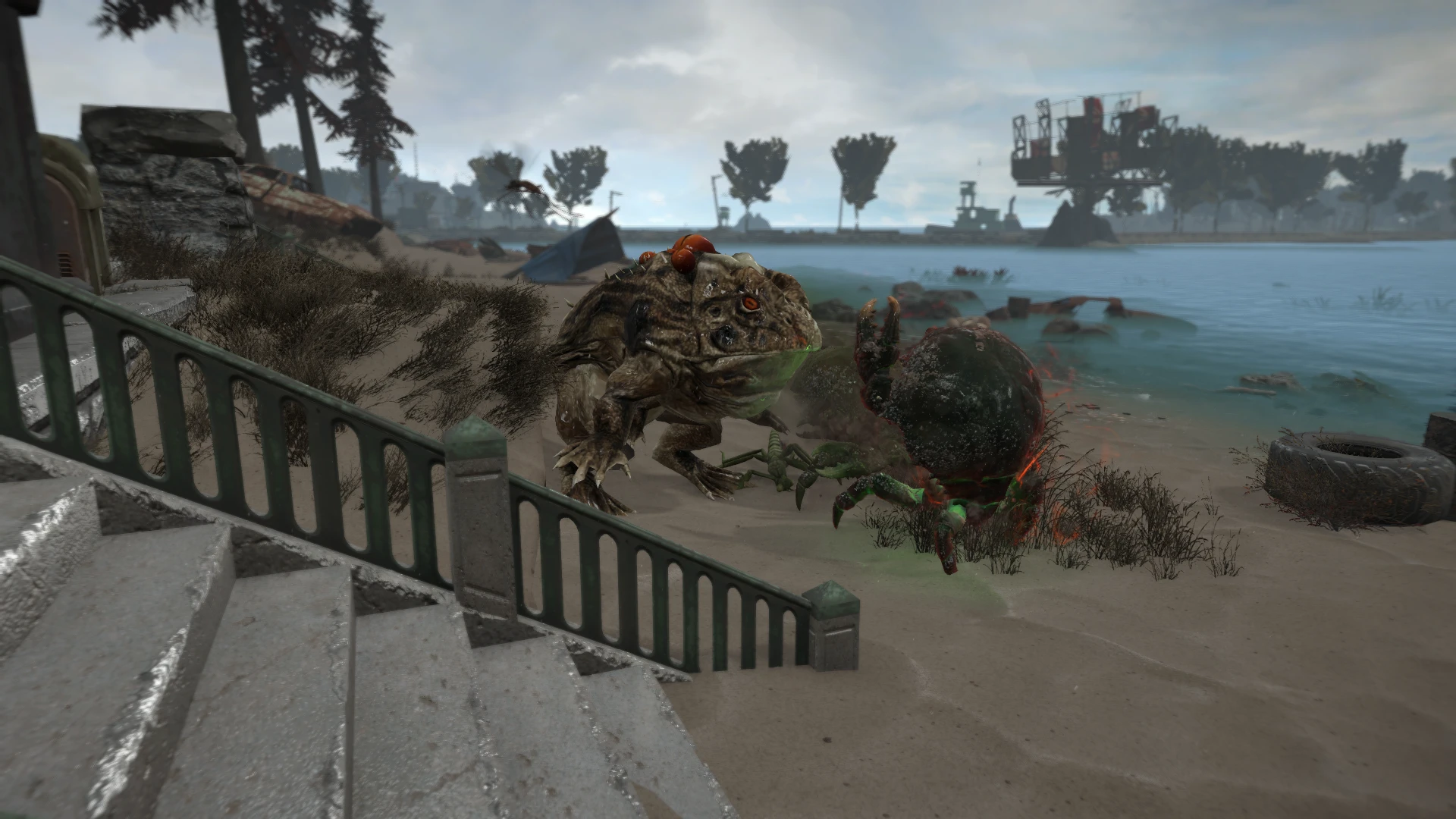
Radtoads
"No amphibian has any right to be that big."
Radtoads were one of the first mutant creatures to develop in the years following the Great War. As time went on, their mutations developed even further, causing the creatures to grow much larger in size. Today, radtoads are hulking, grotesque behemoths wriggling with extra arms and eyes. These slimy predators roam throughout most of the wasteland - always searching for another meal. Engaging one of these juggernauts in combat usually requires either a very, very big gun, a near impenetrable suit of armor, or - ideally - both.
Author's Note: Radtoads have been entirely reworked in 1.2. Being, by far, the worst example of stretching in the game (and just not resembling the common toad) the mesh has been entirely reworked to fit the angler skeleton more properly - and better resemble a mutated common toad. The extra arms from Fallout 76 return, stretching and clipping has been near-entirely removed, and a better texture for the standard radtoad skin has been implemented. Radtoads also now have a chance to be seen carrying eggs on their backs, as an extra bonus! This is, by far, the most extensive rework in the update. One that, I feel, finally does this big bruiser justice!
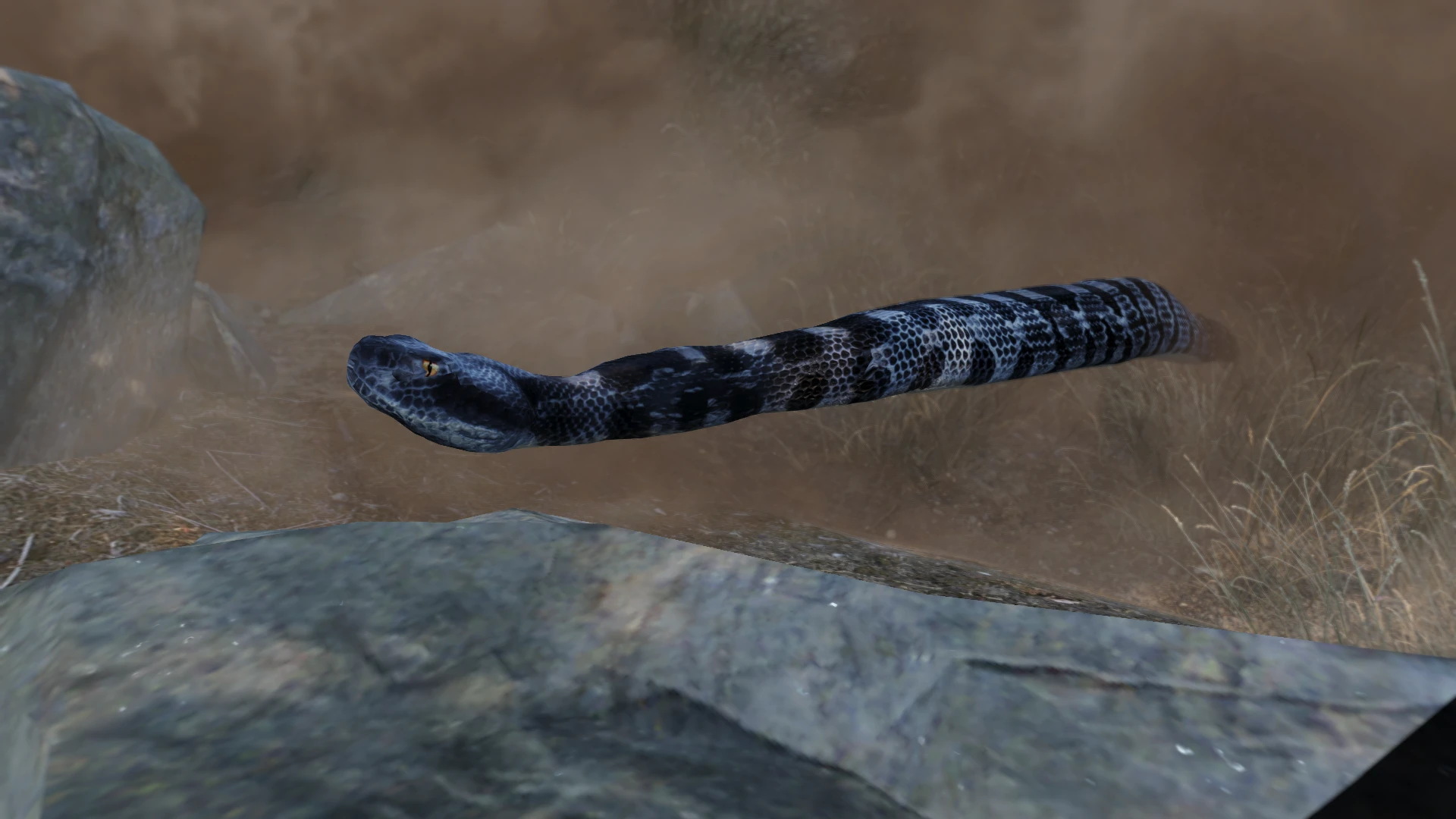
Raddlers
"So gosh-darn angry that they may just convince you you deserve it!"
Raddlers mutated from the common timber rattlesnake found throughout eastern North America. As they grew in size, the potency of their venom faded, while every other physical attribute strengthened significantly. Raddlers are fast, frantic predators – kicking up dust and dirt as they aggressively pursue their prey. Though they’re quick and hard to spot in tall grass or underbrush, most raddlers give themselves away with their loud, rattling tales and the inordinate amount of dust they kick up while on the move.
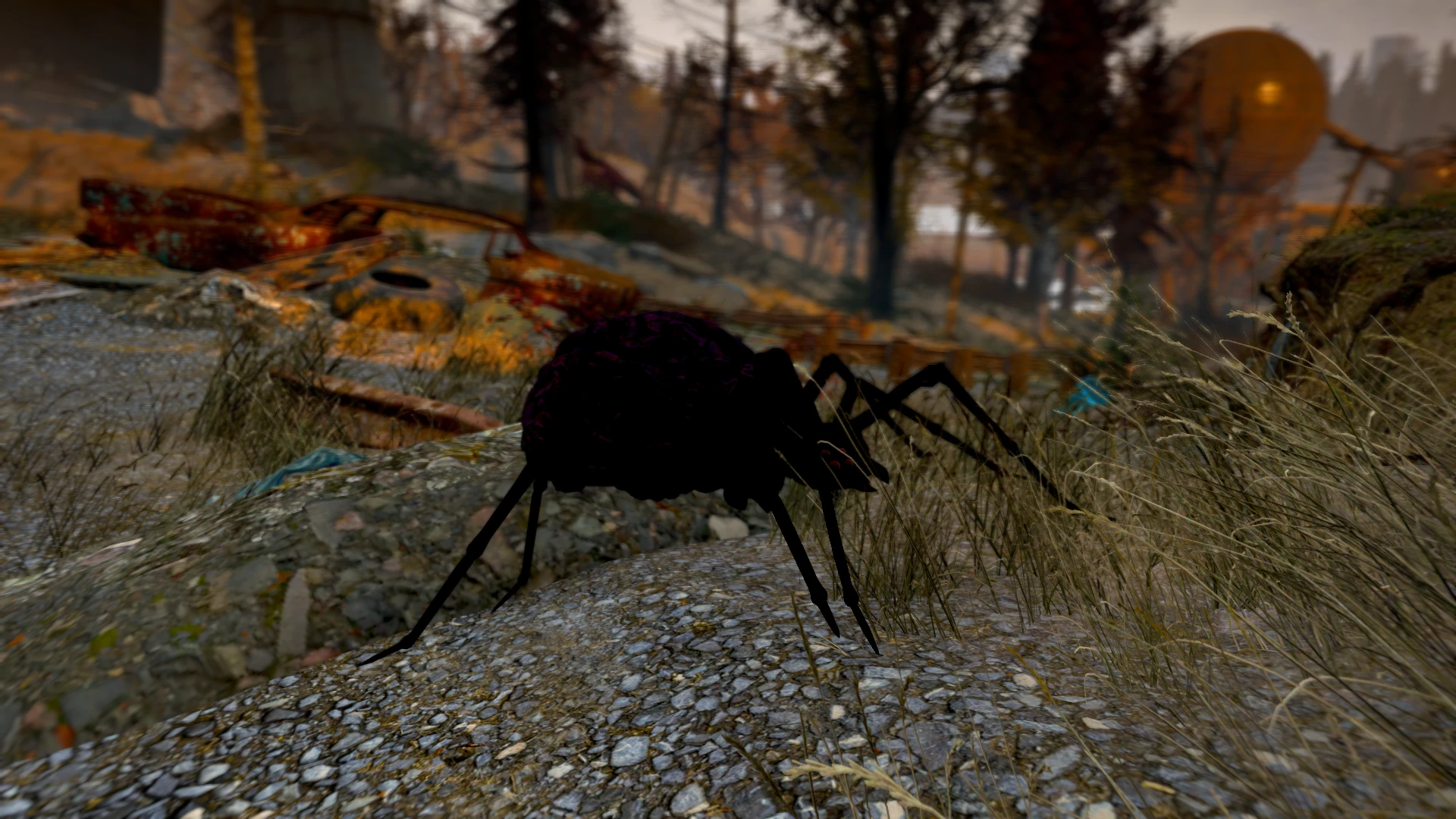
Radrachnids
"Too many legs and just wayy too much pulsating membrane!"
Radrachnids are some of the most loathsome critters in the wasteland. These brainy crawlers originally mutated from the brown recluse spider, adopting a much more grotesque, if psychedelic, appearance in the aftermath of the Great War. Radrachnids live in reclusive packs throughout the Commonwealth, and will often build their nests in remote, ruined buildings or on-or-under abandoned highway overpasses. Their large webs and round, pale eggs that litter their stomping grounds can tip an observant wastelander off to their presence. Picking a fight with a pack of radrachnids is no small task, but the rewards are often worth the risk for more proficient hunters. Everything from their eggs and silk to the chitin and spinneret glands off their bodies can be used or sold. Though best avoided if unprepared, it may be worth noting the location of a radrachnid nest - if you think yourself capable enough to gun the blighters down!
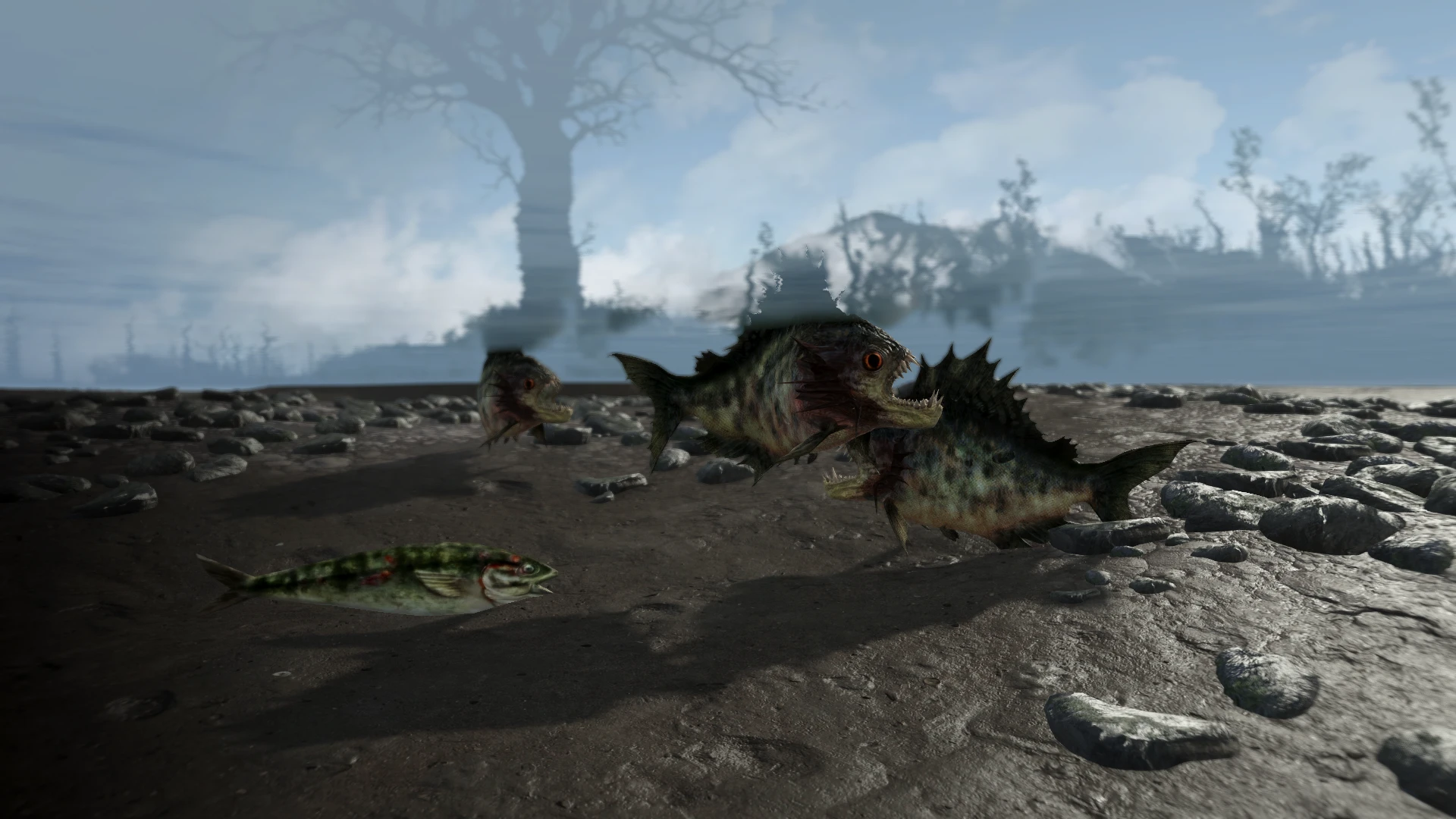
Ravagers
"Not so ‘crappie’ anymore, eh?"
Ravagers are a breed of large, carnivorous fish that roam fresh and brackish waters. These razor-toothed snappers tear through ecosystems, devouring anything in their path. Though many wastelanders equate ravagers to giant piranhas, they actually mutated from the common freshwater fish known as the black crappie. Ravagers infest freshwater river systems throughout most of the midwestern United States and much of the east coast and deep south. They cannot, however, reach water sources that are not connected to these wider waterways - which they’ve used to invade various new ecosystems across the wastes. As such, isolated ponds and lakes do not have established ravager populations. Experienced survivalists understand that when crossing the major rivers of the Commonwealth, finding a sturdy bridge is very much a matter of life and death.
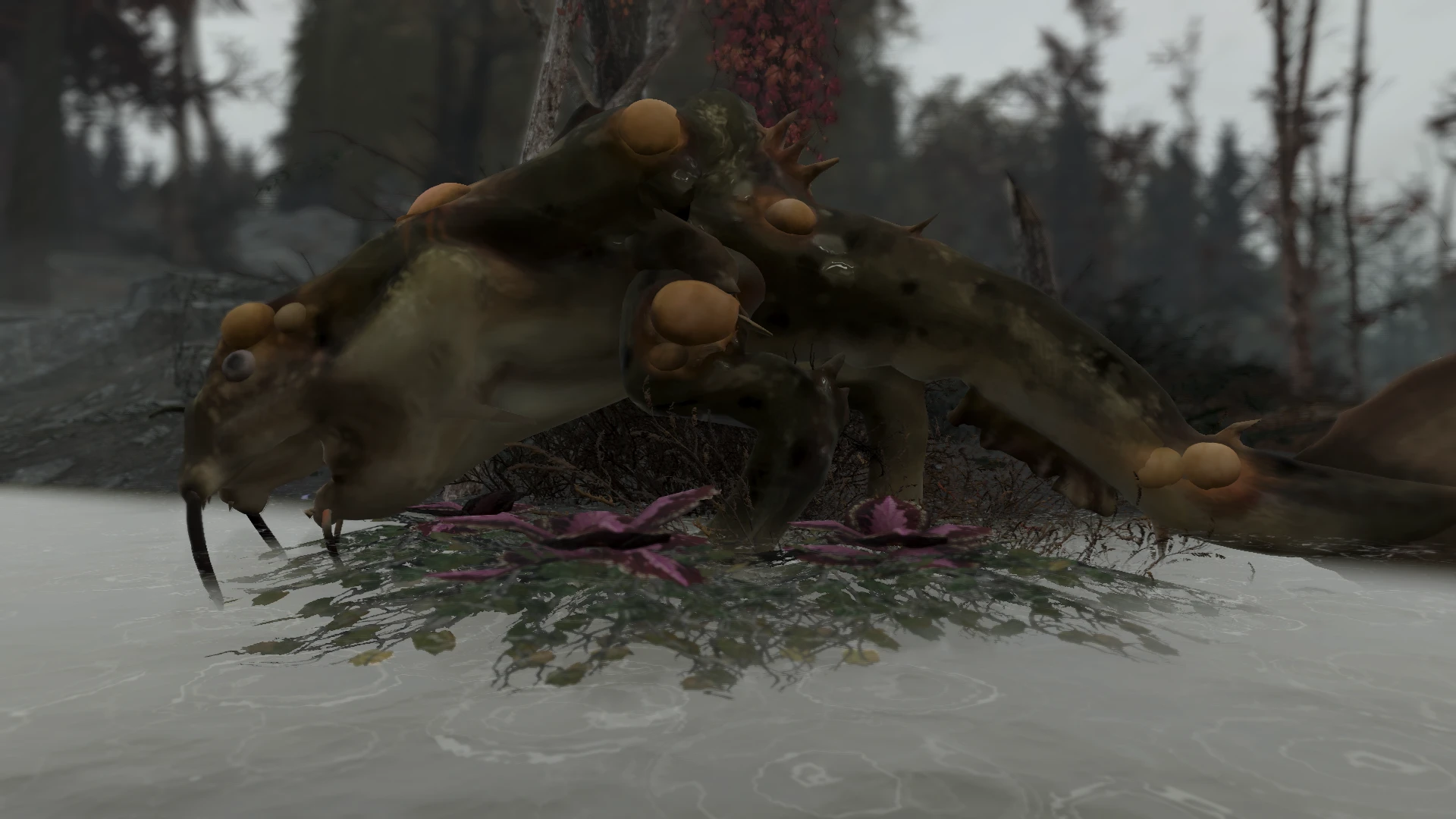
Riverlurks
"Wish these bottom feeders would stay at the bottom..."
If you hear a low growl near the water's edge - ready your weapon. Riverlurks are mutant, bipedal channel catfish that stalk the lakes and rivers of post-war America. They swim along the bottoms of murky water sources, scavenging and hunting in the depths. When something on the surface catches their eye, though, these ravenous deep-stalkers come bursting out of the water. Riverlurks are able to survive for an extended period on land before needing to submerge again, allowing them to terrorize both ecosystems. Riverlurks also share a symbiotic relationship with ravagers - their growls and thrashing often alerting them to threats they otherwise wouldn't notice. What's worse, riverlurks generally hunt in pairs or even schools. If an unlucky wastelander makes the mistake of agitating a riverlurk in populated waters, they may find themselves subject to a feeding frenzy of all manner of aquatic beasties in seconds.
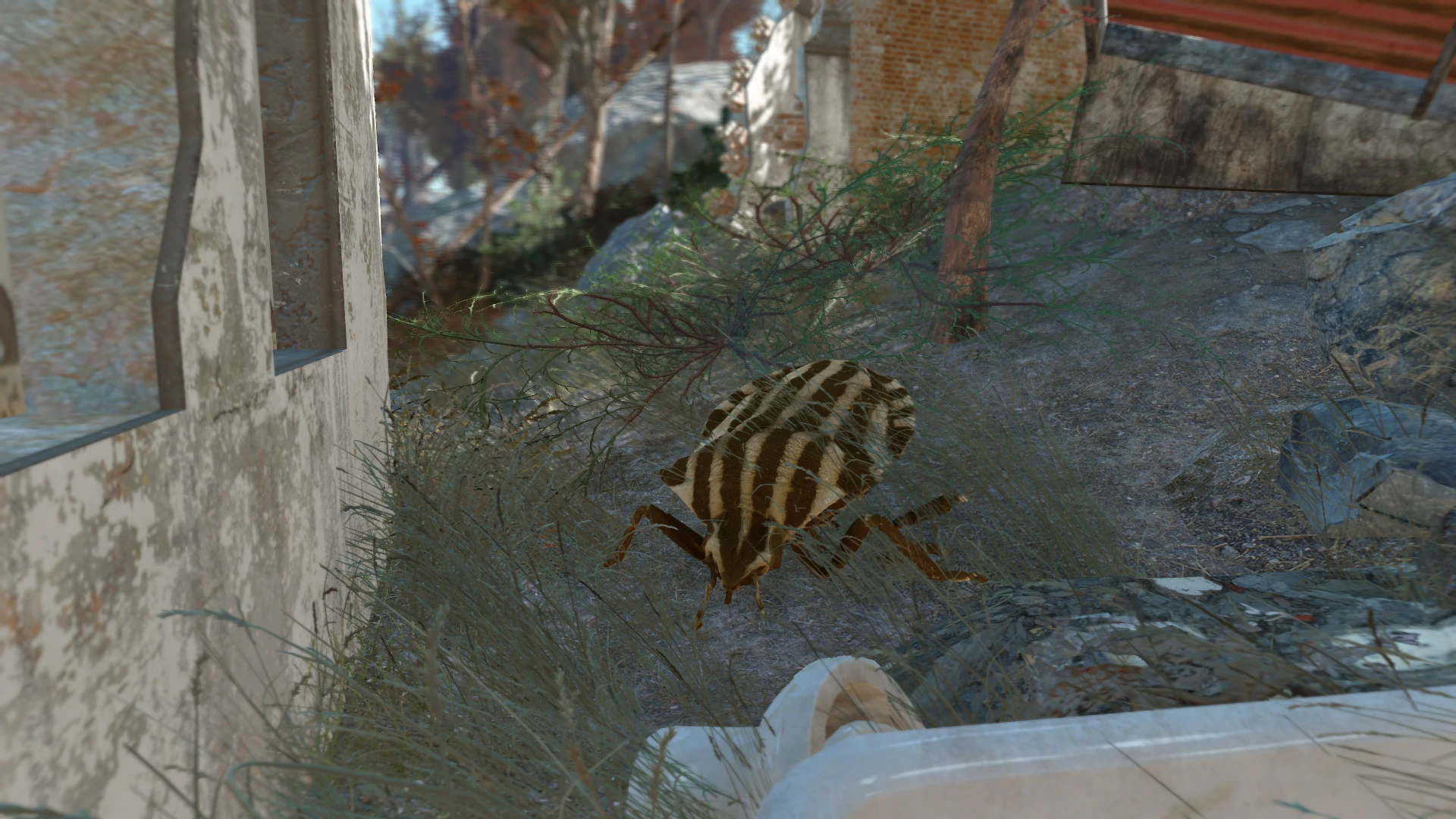
Stinkbugs
"Because sometimes life just isn’t fair."
An invasive species in America before the Great War of 2077, stinkbugs managed not only to survive the end of the world, but fully infest the United States. Stinkbugs tend to grow bigger than radroaches and most boombugs, possess a venomous, radioactive bite, and can take a punch to boot. Somehow, despite all the odds, the stinkbug managed to make itself even less desirable than its prewar counterpart.
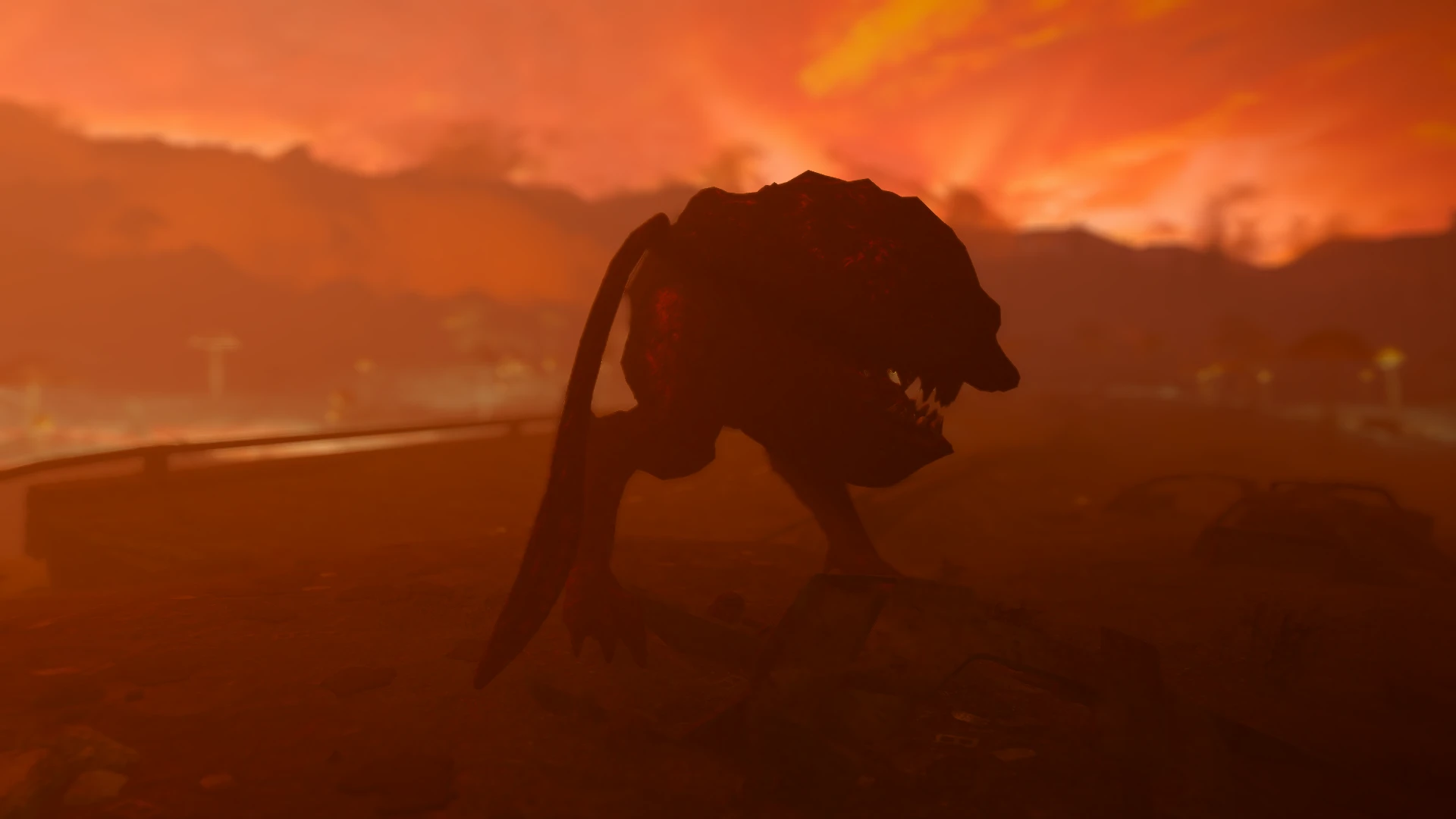
Wanamingos
"You may want to bring a few extra magazines…"
Since the Great War, legends spread across the wastes that alien, otherworldly horrors lurked in the deepest reaches of the world – super predators on par with the mighty deathclaw. Largely referred to as aliens for decades following the apocalypse, this urban legend was given a name in Redding, California in - where a mine of the killing machines was somehow cleared out by an individual known as the 'Chosen One'. In the aftermath, wanamingos were discovered to be subjects of FEV experimentation, and were likely created before the Great War. Scientists theorized that it was also likely that they had been engineered with a biological clock that would prevent further breeding beyond a specific generation. Unfortunately, this theory proved as preposterous in reality as it was on paper, and despite the efforts of various specialists to hunt down the last generation of wanamingos on the West Coast, a number of the monstrosities escaped and persevered. Among these refugees was at least one wanamingo queen - the only variant of these beasts capable of breeding new wanamingos. Like the deathclaw, wanamingos were able to expand throughout the ruins of the United States - settling in the cold, dark corners of wastes. Wherever a population of wanamingos is found, a queen lurks nearby – fostering the next generation of tentacled nightmares away from prying eyes. These nests are usually deep underground, though significant mutations after decades in the wastes have allowed the wanamingos to survive above ground on rare occasions – especially in areas of extremely high radioactivity. The modern mutated wanamingo was first sighted in the Capital Wasteland, and rumors have spread that some of the legendary wanamingos may have also migrated to the Commonwealth.
Other Hostile Creatures Added using Dynamic Spawns:
- Anglers (Far Harbor)
- Bloodworms (Nuka World)
- Cave Crickets (Nuka World)
- Fog Crawlers (Far Harbor)
- Gulpers (Far Harbor)
- Hermit Crabs (Far Harbor)
- Radant and Swarms (Nuka World)
- Radrats (Nuka World)
- Vicious Wolves (Far Harbor)
PASSIVE WILDLIFE (STATIC ACTORS)
"They really just wanna be left alone"
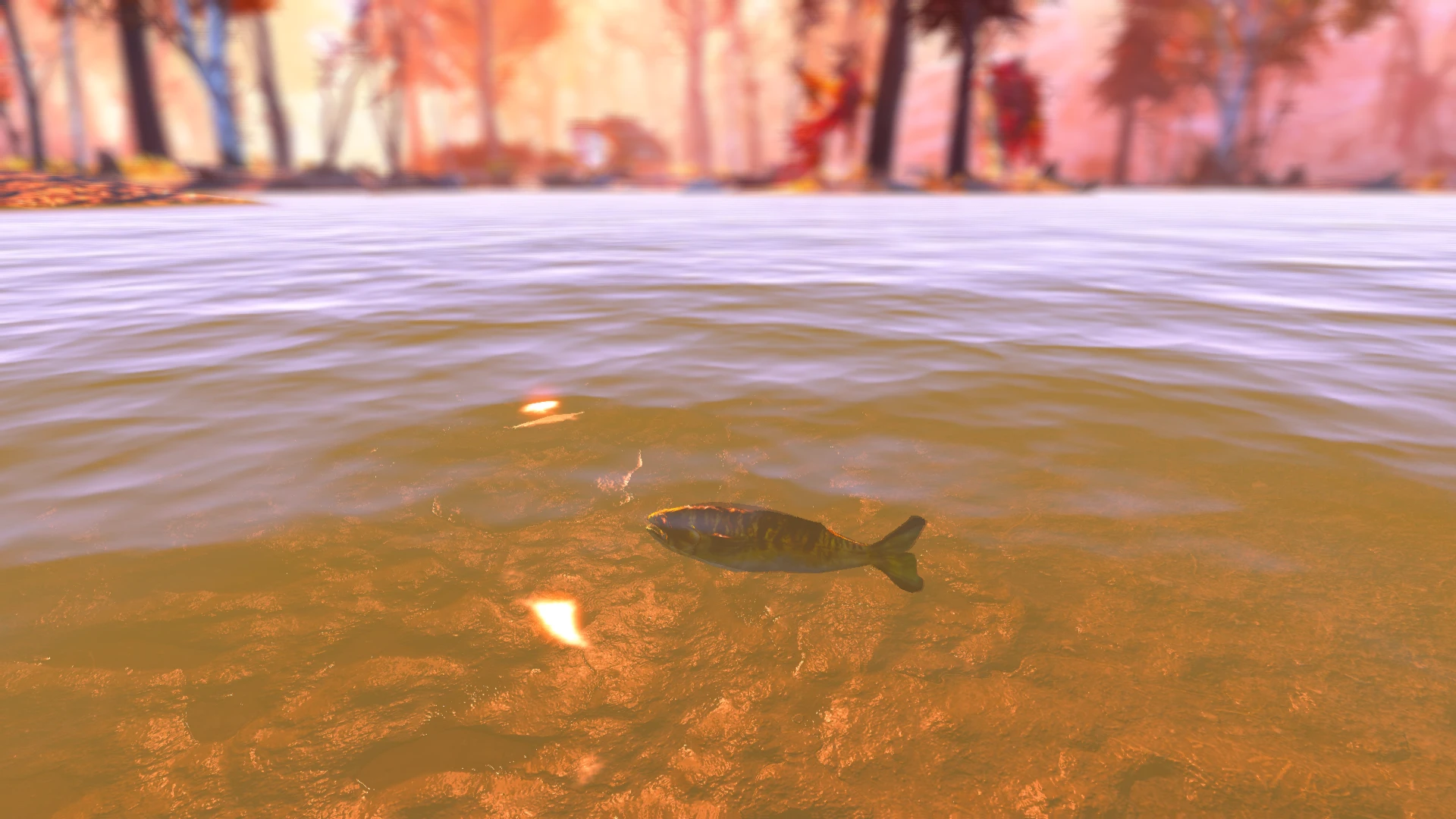
Freshwater Fish
"It's just refreshing to see things that don't want to kill and devour you."
Freshwater (and saltwater) fish of different species and sizes can now be found swimming peacefully throughout the Commonwealth's water sources! They're found in every major water source and most minor ones. Expect to find irradiated shad and bass wherever you go!
- American Shad - Shad are a species fish found in large lakes, ponds, rivers, and in the Atlantic Ocean! These plump, pale fish have one of the widest ranging ecosystems of all sea life in the Commonwealth.
- Largemouth Bass - Bass are one of the most common gamefish in America. Like many other black bass, largemouth are freshwater carnivores found in lakes, ponds, and rivers. Other than minor radiation damage, largemouth are largely unchanged.
- Smallmouth Bass - Another member of the black bass genus, smallmouth are famous for their autumnal coloration. Preferring streams, creeks, and river ecosystems, high smallmouth populations were thought to be indicative of a healthy ecosystem before the Great War. Today, not so much.
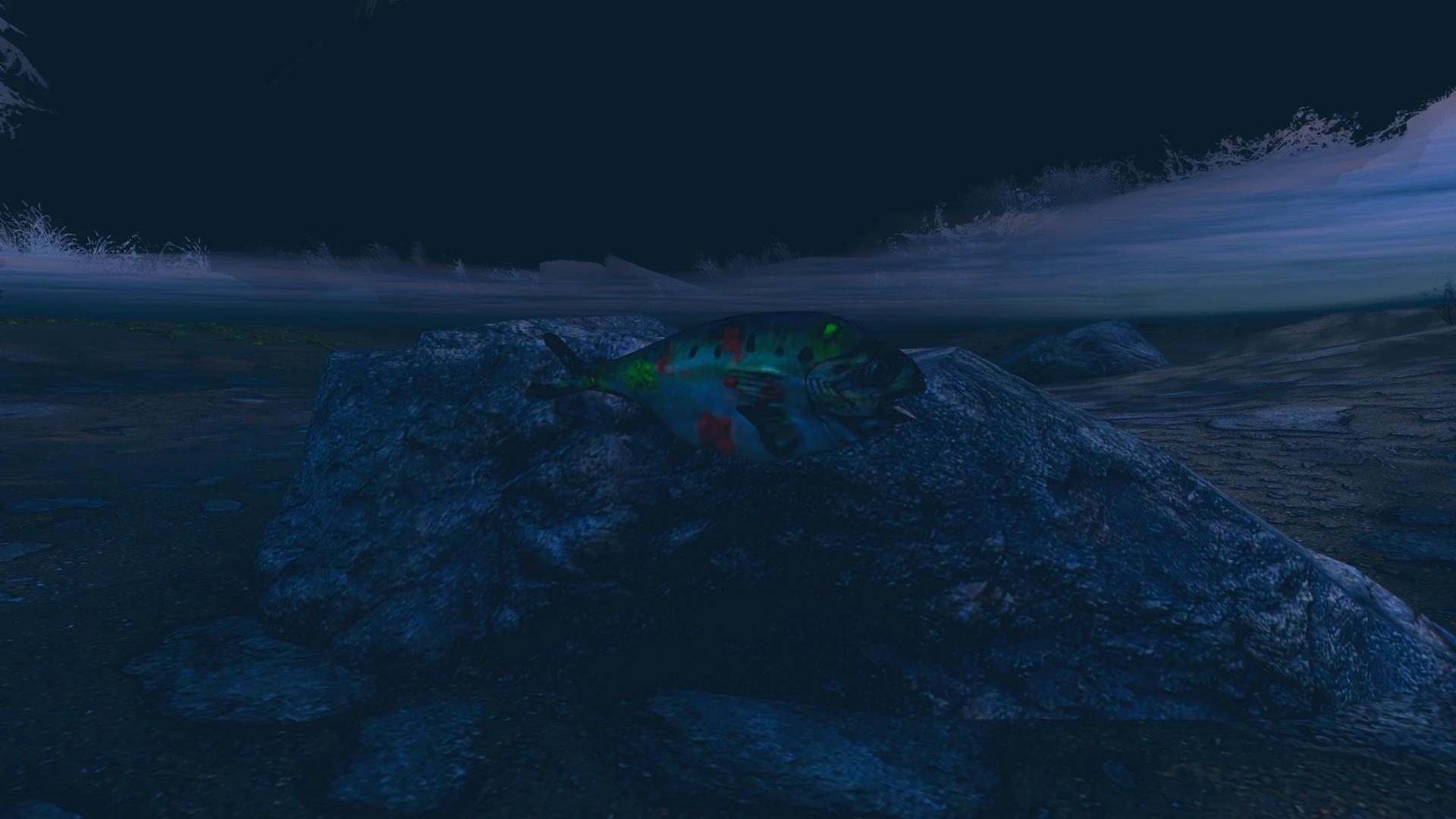

“We get by with a little help from our friends.”
The following mods are mods I recommend running alongside Mutant Menagerie for the best possible experience, in no particular order:
Faded Glory - A Post-Apocalyptic Soundscape - Practically the soundtrack of this mod, as it never left my load order during development.
Commonwealth Conifers Redux (Autumn) - The environment mod that never leaves my load order. True to the nuclear autumn tone and style of the base game. Mod was taken down due to the Nexus controversy, so linking a video showcase until a mirror is uploaded somewhere else by the author.
Wasteland Imports - Goodies from all across the Wasteland... - Very close to the spirit of Mutant Menagerie in what it does. Additive, expansive, and lore friendly in its integration of items from other Fallouts - this is a perfect compliment to Mutant Menagerie. In fact, this mod hasn't left my load order since 2016, and Mutant Menagerie's recipes were very much built to work alongside Wasteland Imports seamlessly.
You Are SPECIAL - An excellent perk and skill overhaul for your next playthrough. works great with mods like Mutant Menagerie that are meant to expand on the different possible playstyles in Fallout 4 - further enhancing your RPG experience.
NAC X - NATURAL AND ATMOSPHERIC COMMONWEALTH 10 - Legacy Edition - In my opinion, the best weather mod out there. Its enhancements to the Glowing Sea in particular are fantastic, and are front and center in the screenshots for Mutant Menagerie.
The Fungal Forest - The Fungal Forest is a fantastic addition to the Glowing Sea, and is featured in many of the screenshots on Mutant Menagerie's page.
FO4 Photo Mode - This mod is how all the screenshots for Mutant Menagerie were captured. I love it dearly and will never uninstall it.
IHO - Immersive Hunting Overhaul - A fun and immersive hunting overhaul for Fallout 4. Adds a more in-depth hunting mechanic, and the mod author has worked hard to add support for Mutant Menagerie - specifically. Give it a try!










